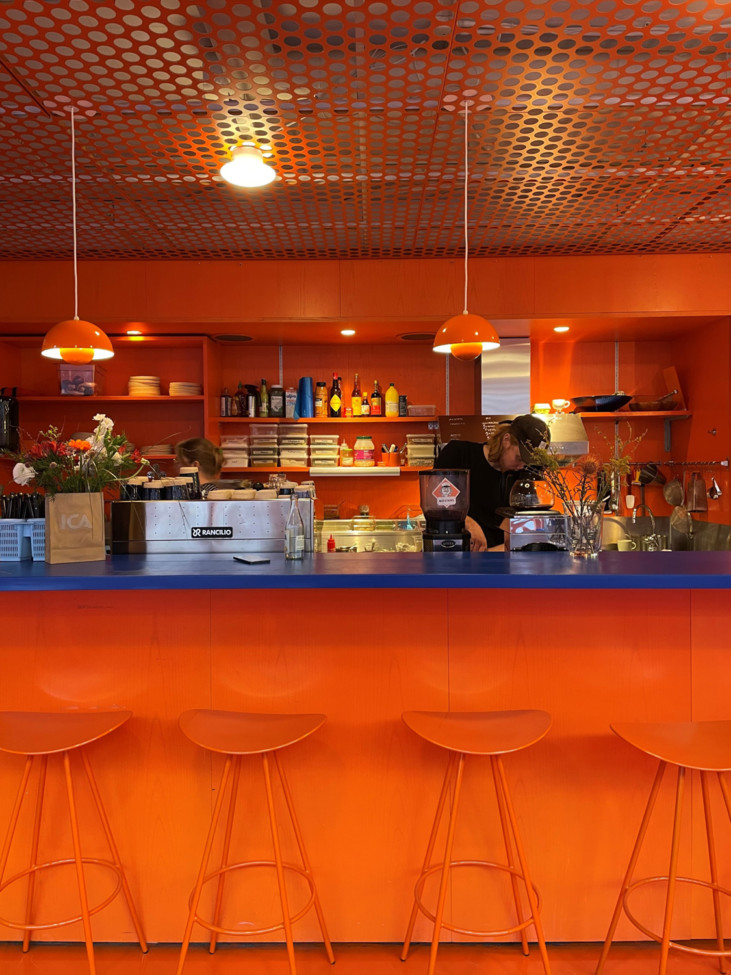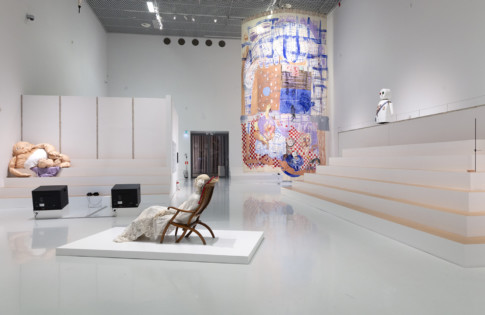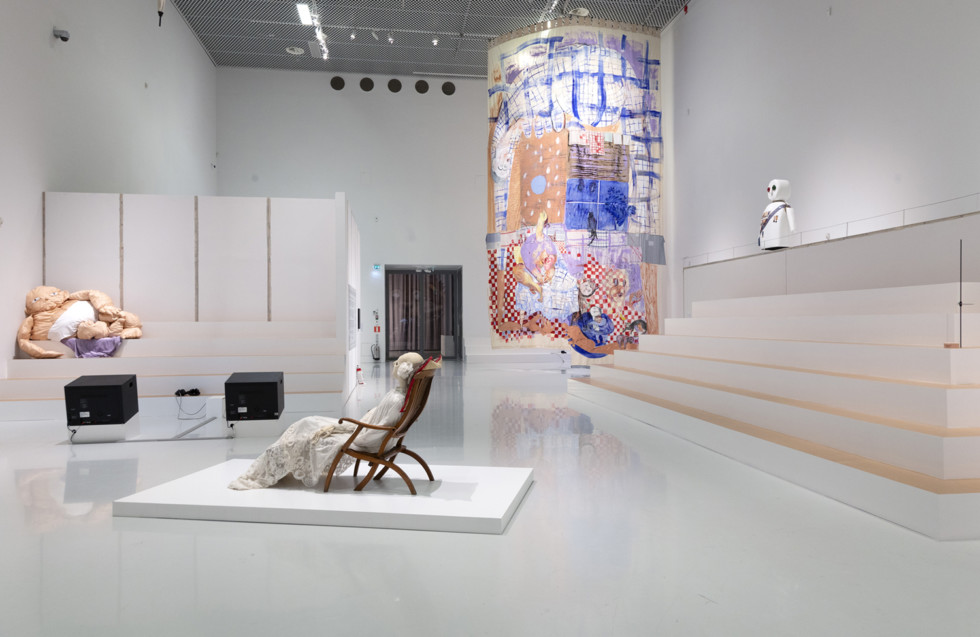
Installation view with Jenny Kalliokulju, Maman or The Tounge, 2024 Photo: Lena Wilhelmsson
About the artworks in On the Absurd Drama That Is Also Life
Through the practices of the artists, where the low-key meets the expressive, something fragile emerges – a tear in the fabric of reality that leads the eye in new directions.
The exhibition reflects an uncertain, fragmented present where fiction and reality mix. But it also extends all the way back to 1916, when the art movement Dadaism was formed. Artworks created in a variety of artistic expressions and techniques meet and interact, several works are closely related to theatre, drama, and performance. Apart from newly produced and recent artworks by contemporary artists, the exhibition also includes works from Moderna Museet’s collection.
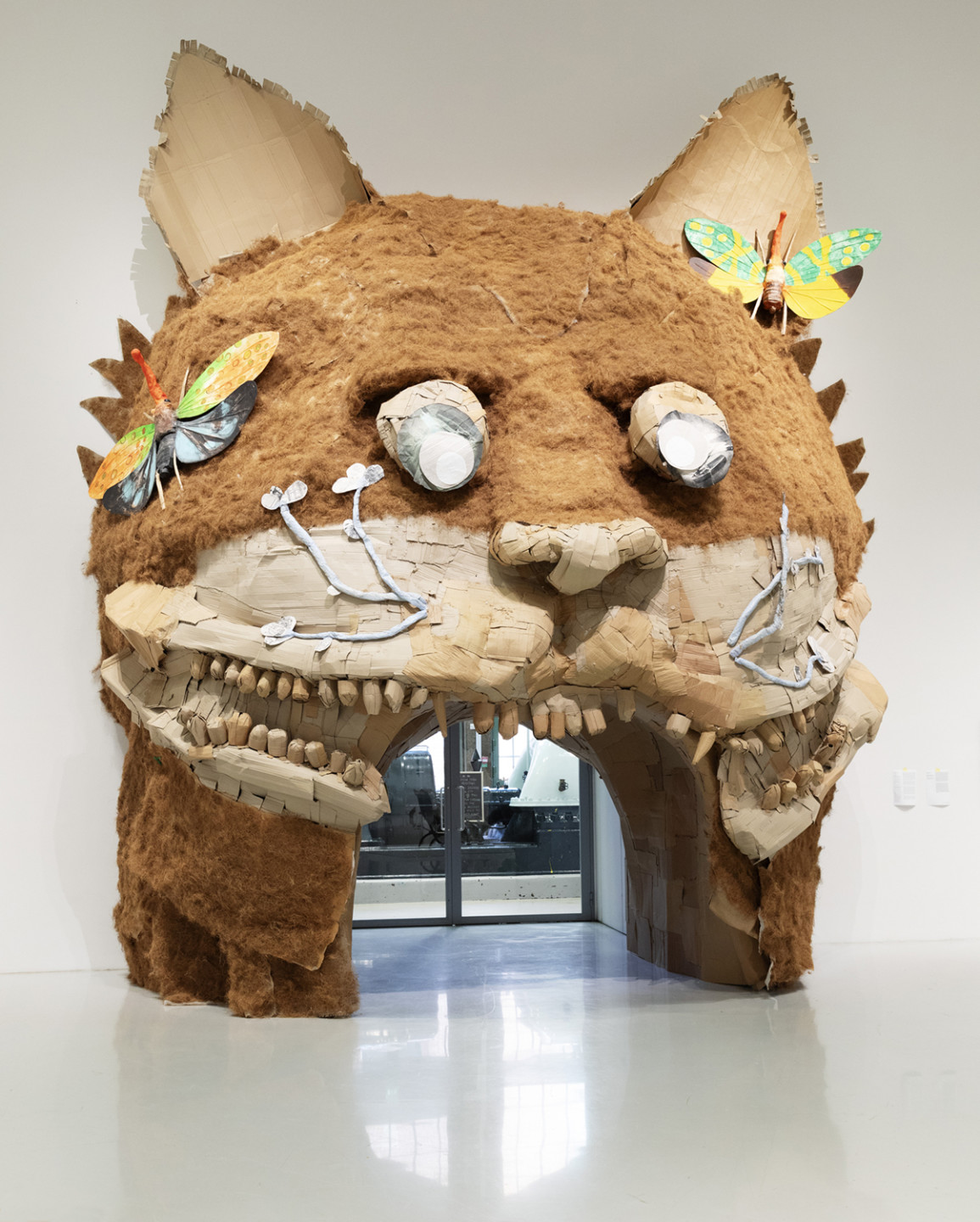
Monster Chetwynd
b. 1973
UK
Cat Head, 2022
Lantern Fly (Pastoral), 2021
Lantern Fly (Mars&Venus), 2021
Monster Chetwynd’s artistic work borrows, explores and mixes both iconic moments from cultural history and more contemporary popular culture. Per practice, which encompasses, amongst others, installation, performance and painting, has its own distinctive style, marked by improvisation and spontaneity in its execution, yet always based on thorough research. In the exhibition space at Moderna Museet Malmö visitors are met with the enormous Cat Head and a pair of lantern flies in Toxic Garden – built from simple materials such as cardboard, cloth and wood. It has a welcoming way about it, inviting the viewer to enter through the cat’s mouth and out into the museum’s workshop.
For the exhibition Monster Chetwynd also produced a new cabaret-like performance, with the title The Evolution of Cat People, which was presented as a kind of kick-off of the exhibition itself. Chetwynd’s work has an ability to capture life as an at times irrational state, and to create something hopeful in everyday drama.
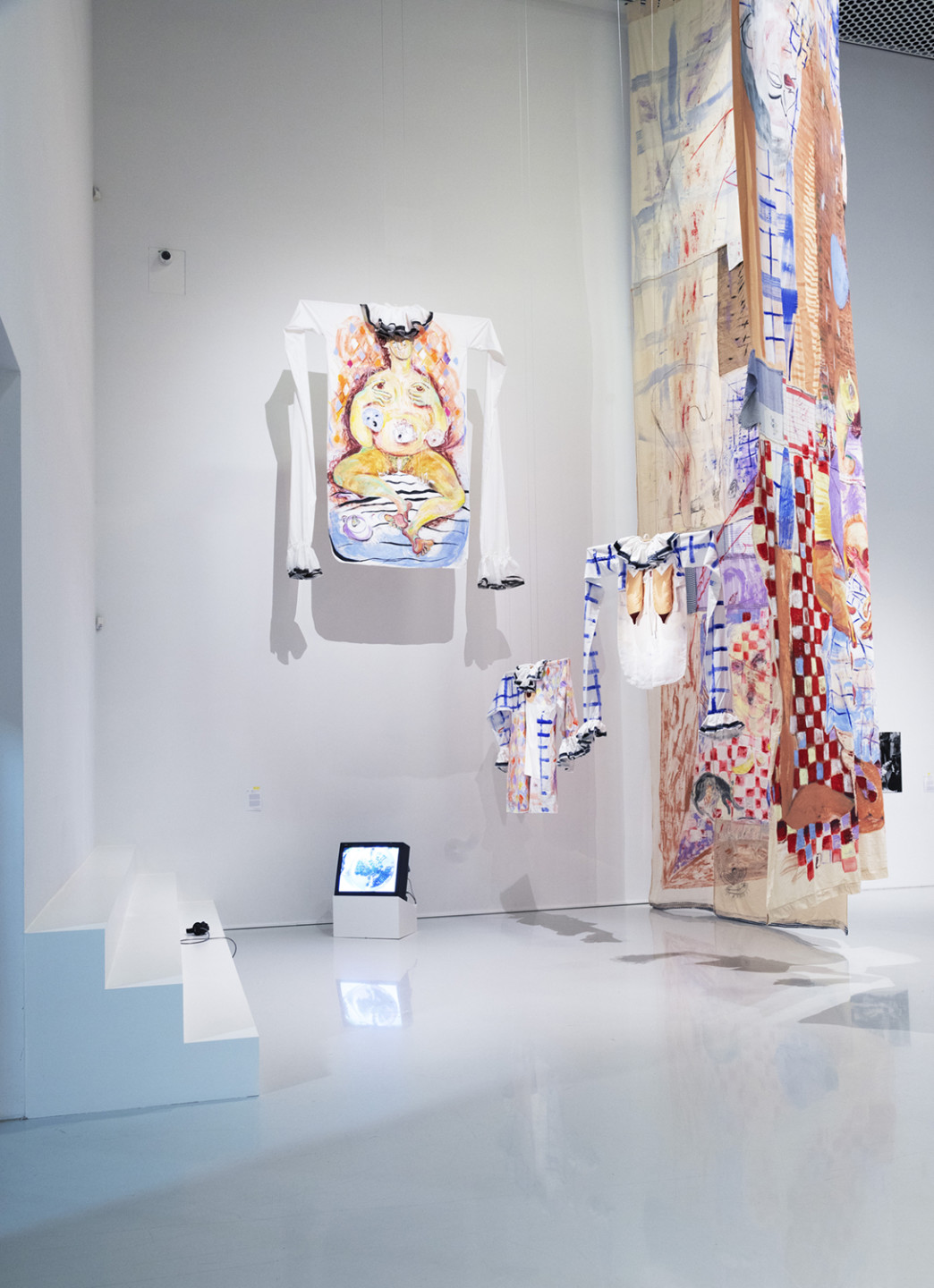
Jenny Kalliokulju
b. 1986
Sweden
The Everydayayays
Oil, acrylic and ink on fabric
MAMAN, or THE TOUNGE, 2024
Oil, acrylic and ink on textile/costumes, fabric sculpture, wooden furniture, opera, text, scenography
The role of the family and the cycles of the everyday are addressed in the experimental feminist chamber opera MAMAN, or THE TONGUE, in which the artist and writer Jenny Kalliokulju interweaves art, song, music and theatre. The aim is to create an interdisciplinary, anti-hierarchical Gesamtkunstwerk, in which a painting installation also takes the shape of scenography and costumes during the performance of the opera. Kalliokulju’s paintings appear ephemeral and spontaneous in execution, oscillating between the abstract and the representational. In the new paintings, there is also a strong narrative element where the time of everyday life is captured.
Formally, Kalliokulju’s work is often a collaboration (real of fictitious) with other artists, writers and academics. In the libretto, these voices form a choir and a dialogue together, which evokes a universal state of existential reflection and a striving for co-existence. The libretto comes from the artist’s own experiences as a mother of two. Everyday life, feelings of inadequacy are all palpable. Yet, despite its personal point of departure it captures a strongly familiar situation of everyday life’s cycles of relationships and physical bodies.
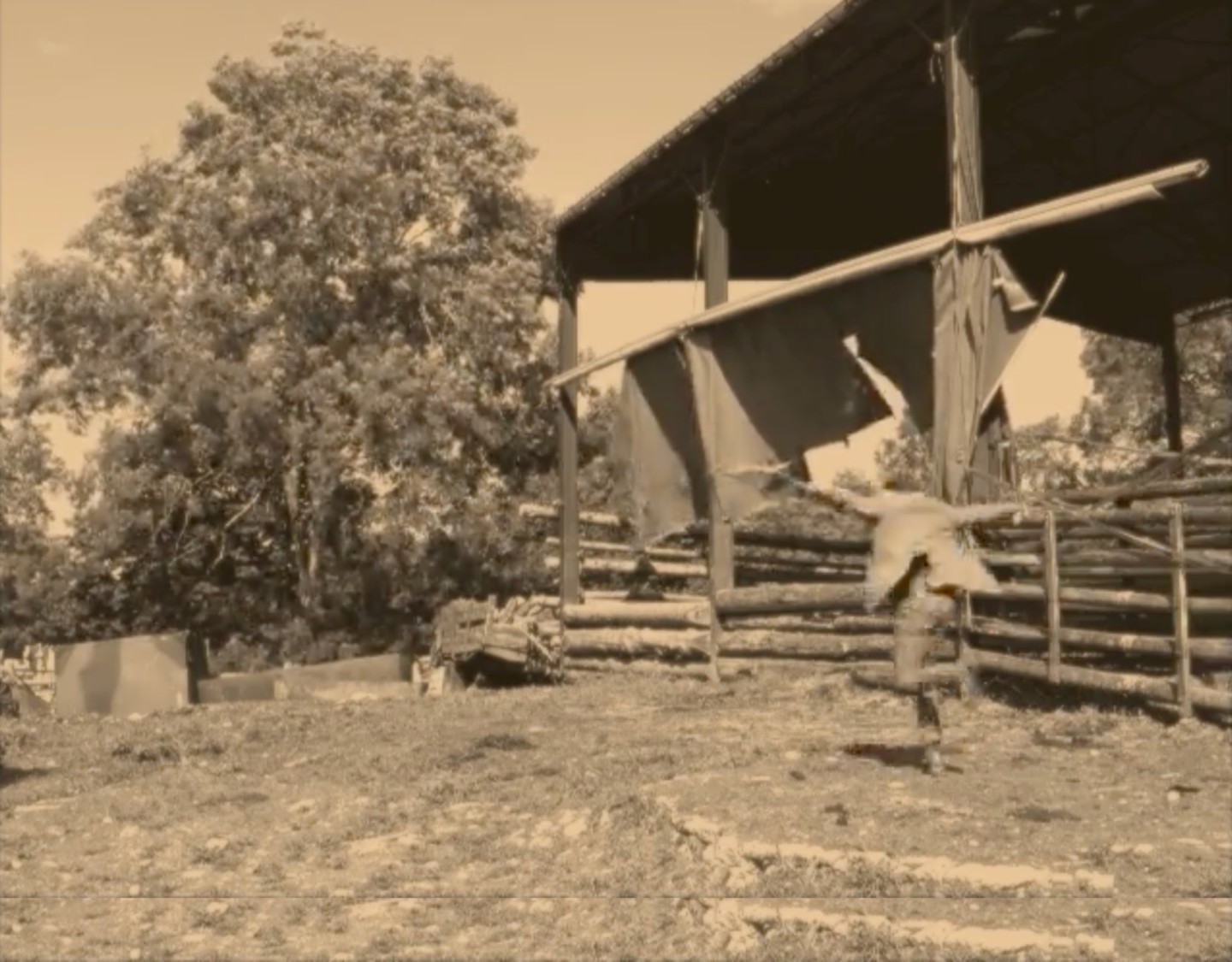
Samson Kambalu
b. 1975
Malawi
Strip Lander, 2019
Video
Cathedral, 2016
Video
Mountain Man, 2017
Video
I Cross a Photograph 3, , 2016
Video
Achilles and the Tortoise Crop Reel, 2021
Video
In Samson Kambalu’s series of films with the collective name Nyau Cinema (2012–ongoing), freedom in public spaces is captured in a manner that is both direct and unassuming. In the form of short subtle film sequences, the artist interacts and performs in different outdoor environments. Each short film shows Kambalu performing some sort of action without any apparent meaning. The artist mentions films from the early years of cinema featuring the likes of Buster Keaton and Charlie Chaplin as part of his reference material. The term Nyau refers to a secret society in Central and Southern Africa with a tradition of dancing, rituals, costumes and masks. These masks have been described within Nyau as “spirits of the deceased and ancestors”. The Nyau tradition’s (both terrifying and playful) approach to life has been a strong inspiration for Kambalu, at times combined with the social criticism of the Situationists which emerged in the 1950s. This is particularly palpable in Kambalu’s use of public space that can be seen as an extension of the Situationists’ interest in urban spaces and their possibilities.
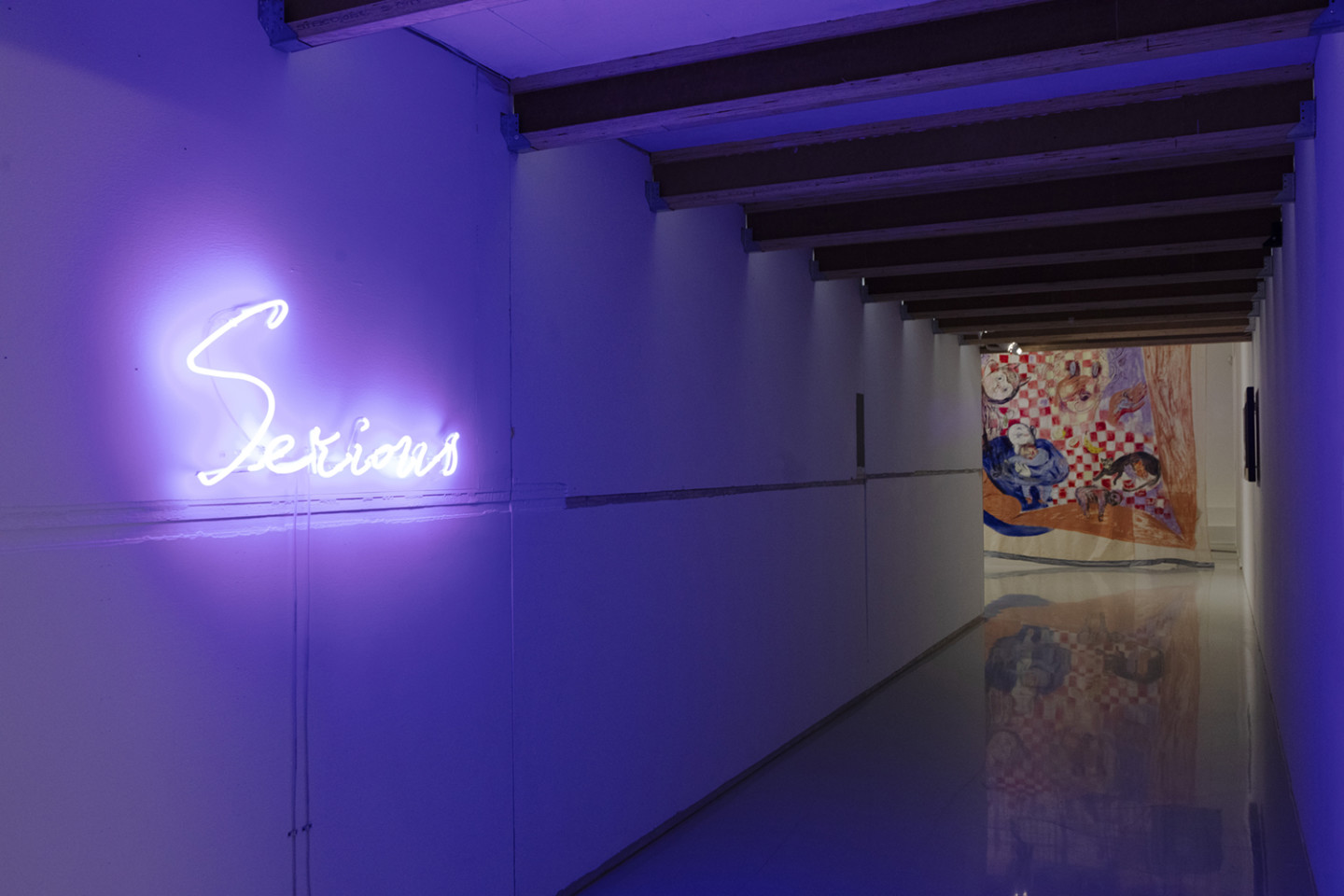
Laura Kaminskaitė
b. 1984
Litauen
Some places to which we can come and for a while be free to think about something else, 2024
Serious, 2023
Permanent Vacation, 2021
Sugar Entertainment, 2011 – pågående
Laura Kaminskaitė’s neon piece Serious is allowed to set the tone for the exhibition as a whole and at the same time ask the question what is actually serious. The question plants itself and widens the perspectives. Yet, at the same time, similar to Kaminskaitė’s work in general, it leaves it open to the viewer. The word “serious” in all its scope, seems to dissolve into something baffling that can mean everything and nothing in today’s discourse. Presenting it in the form of a lavender neon text sign makes the viewer’s experience of the word even more uncertain. Kaminskaitė’s subtle artwork captures a constant process of meaning-making, where fluid language leads the viewer to stray off the path, in both the mental and the physical space.
High above us, suspended from the ceiling and quietly waiting: two oversized, foldable umbrellas created by Kaminskaitė and entitled Permanent Vacation – at title borrowed from director Jim Jarmush’s first film. Close at hand but still out of reach. There always seems to be a forgotten umbrella somewhere that carries both memory and history. But why would anyone even need an umbrella in this space, so strongly connected with the exhibition as a medium, both isolated from and linked to the world around it. And also placed in this room, we find a smaller white cube, reminiscent of the gallery space. Kaminskaitė’s small-scale object Sugar Entertainment, is a hand-made sugar cube with an assumed ability to register and absorb what it witnesses in the space. In the end, it carries a whole exhibition and at the same time perhaps also adds a little sweetness to it.
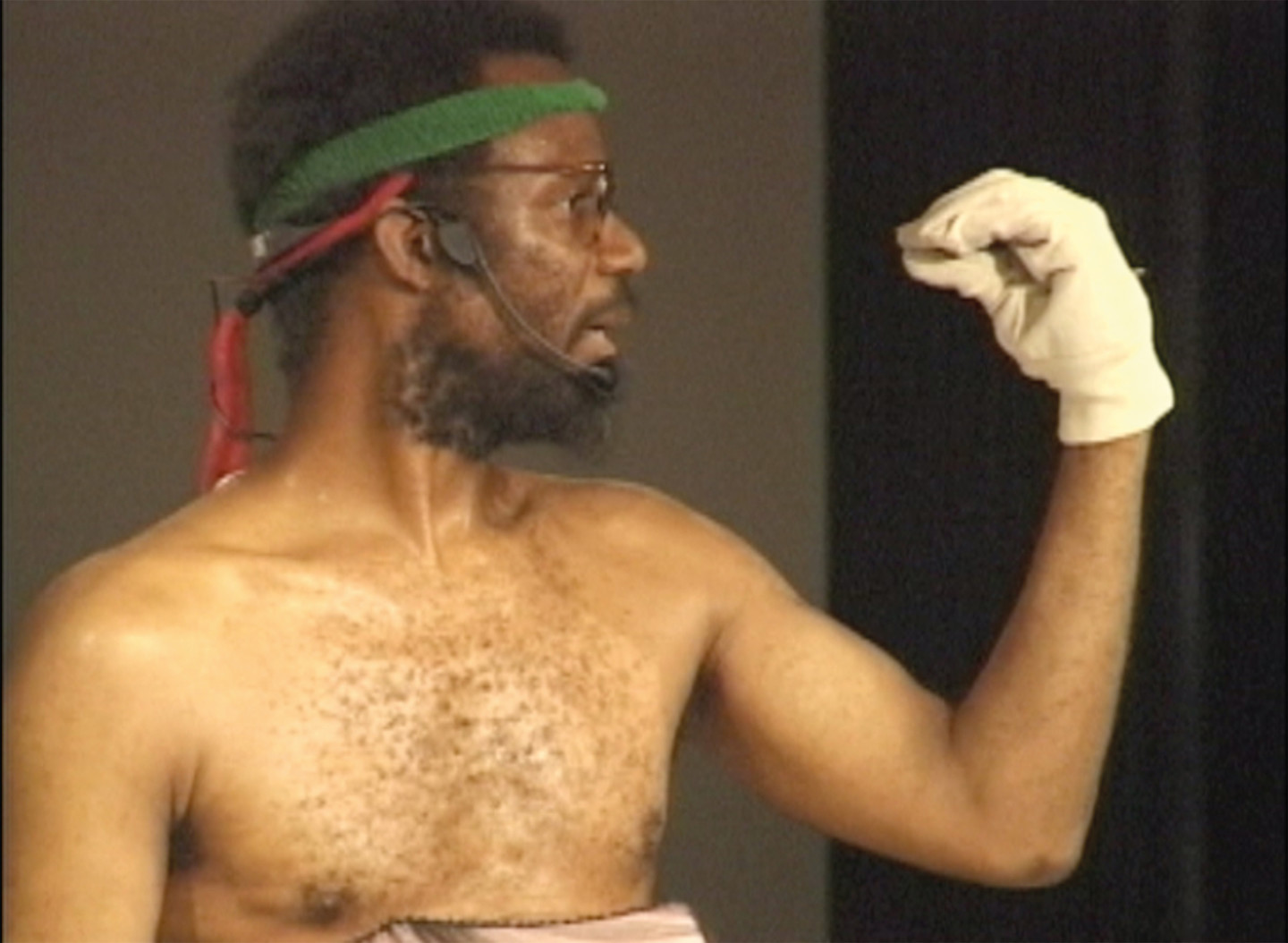
Pope.L
1955–2023
USA
Eracism (version 8b), 2000
Video
Egg Eating Contest (basement version), 1990
Video
Pope.L’s artistic practice and aesthetics are hard to categorise. He moves between theatre, performance and visual art, seemingly as freely and naturally as he moves on stage. Pope.L has referred to himself as “a fisherman of social absurdity”, and since the 1970s his work has criticised a culture and a society that is consumed and divided by inequitable conditions. Now as then, Pope.L’s work surveys a dysfunctional society in dissolution. He is also often called “the friendliest Black artist in America”.
Eracism (version 8b) is one of Pope.L’s most theatre-like performances. The work slides between a theatrical form and something that sometimes resembles stand-up comedy. The monologue that sometimes rhymes, conveys anecdotes, observations, fantasies and speculations about the Black body, and its relationship with the white, but also about homophobic memories. In Pope.L’s work, language becomes almost physical – a flow of words being given shape and form. And the credibility with which the monologue is performed highlights the absurd grey area between theatre and life that the artist seems to be well aware of.
Pope.L’s performance Egg Eating Contest (basement version) revolves around racism, the Black body, white power and the repercussions of slavery. The performance is at once sad, horrific, vulnerable and humorous, depending on what you choose to consider – the text, the historical content, or a slightly absurd performance with exaggerated and clown-like body language. Pope.L’s work brings to mind slapstick-humour, in which comedy meets tragedy in a direct manner that sometimes incorporates aggressive elements. With the simple and effective tools of humour, wounds and truths open up, exposing historical and contemporary problems and inequalities.
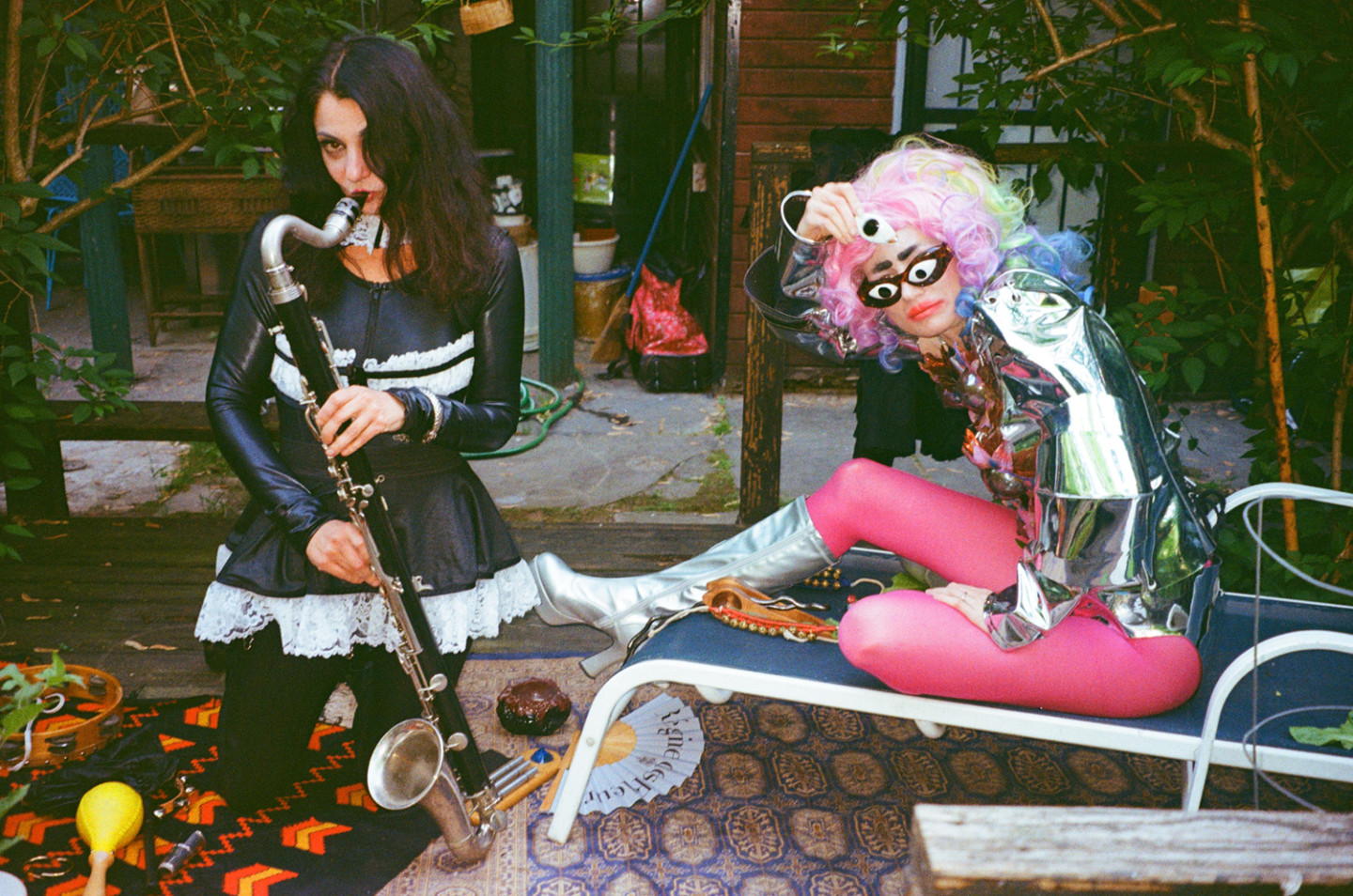
Kris Lemsalu & Johanna Ulfsak
b. 1985 & b. 1987
Estonia
Old Piano, 2024
Video
The everyday stage for apparently surreal spectacles and dramas twists in many directions. This is not least true for Kris Lemsalu’s practice, where life and art meld seamlessly. Lemsalu’s colourful, vibrant and elusive works create a space in which different times, cultures and ideas meet. It’s an environment beyond those that we know, that at the same time seems natural. Full of life, energy and joy, as well as sadness, melancholia and reflection. It’s precisely these different phases of life that are encapsulated and conveyed in Lemsalu’s rich world, where characters converge in their own universe.
Lemsalu’s autobiographical drama documentary Old Piano is created in collaboration with artist and close friend Johanna Ulfsak, and filmed in Tallinn, New York, Vilnius, Mexico City and Bucharest. In the video we follow the artist’s alter ego, the superhero Donatella Privada, who wears eyes like glasses and who during her long life’s journey is constantly surrounded by her friends and colleagues. Subsequently the film oscillates between intense dance scenes, spanking in the kitchen and calm(er) nature scenes. It’s precisely this collective aspect that is central, and Kris Lemsalu’s social life and artistic production seem to co-exist – they unify, develop and propagate in a constant symbiotic dance in which everyone holds each other’s hands.
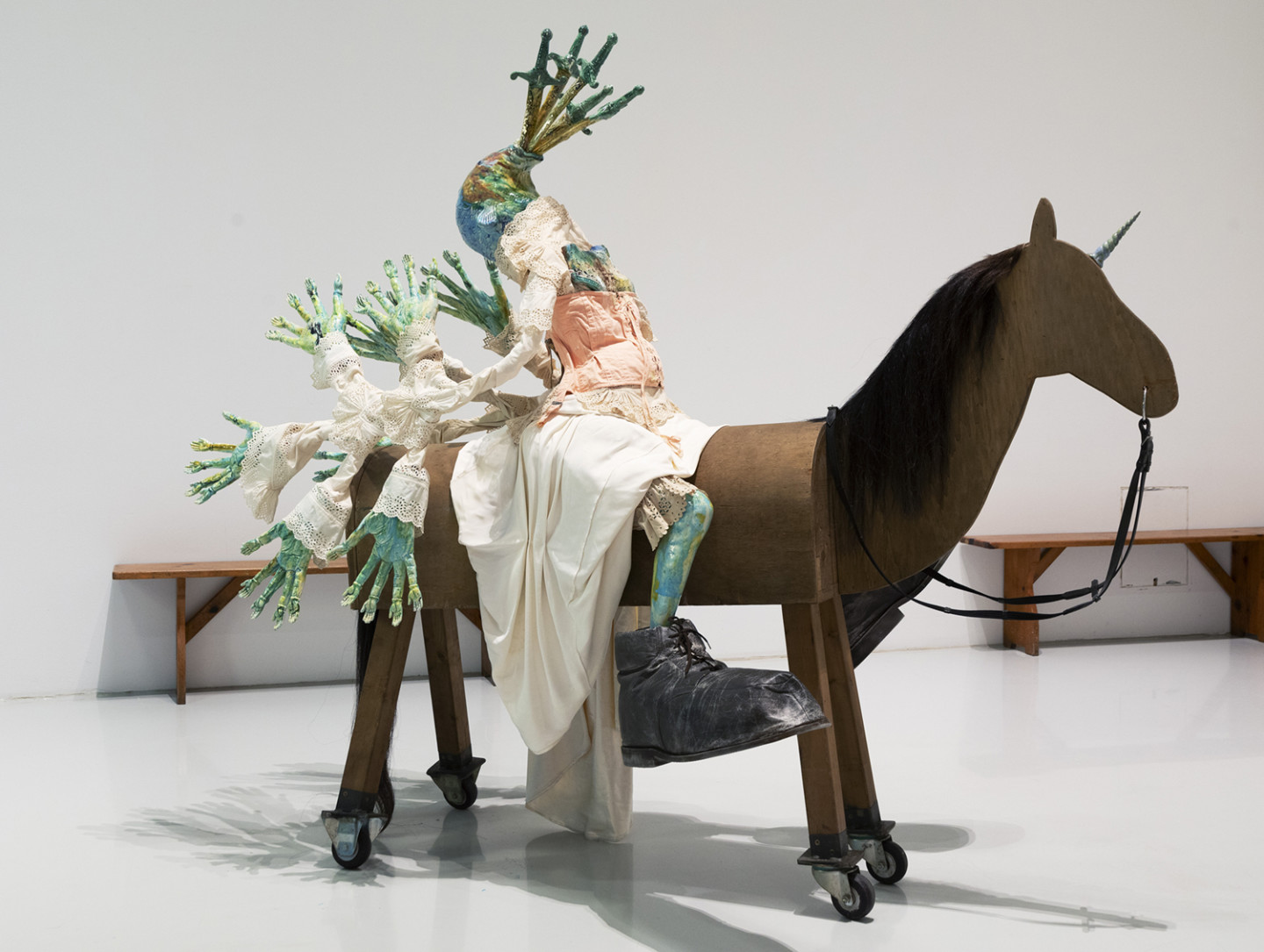
Kris Lemsalu
b. 1985
Estonia
River Rock Bird Sky, 2022
Purchase 2024
Kris Lemsalu’s sculptural artworks often bring together ceramics, textiles, silicon and found objects. These sculptures grow together with costumes, performance and collaborations with friends and family into a Gesamtkunstwerk, which touches on the great existential themes like life, death, birth, loss and desire.
In Kris Lemsalu’s sculpture River Rock Bird Sky the viewer encounters a sword swallowing fish-like figure, sitting precariously on a Trojan Horse that also is a unicorn. The figure wears oversized boots and clothes that bring to mind the lace and corsets of the Romantic era. It is undoubtedly a member of Lemsalu’s family of sculptures – fleeting, playful and strong in character. River Rock Bird Sky emphasises the ability to take on different forms, depending on what the moment requires. The title of the work hints at a struggle between the volatile and the static and where the possibilities are endless.

Kira Nova & Ignas Krunglevičius
b. 1982 & b. 1979
Lithuania
The Idiots, 2024
Video
Kira Nova’s artistic work is hard to categorise, falling between dance, physical theatre, Butoh dance and stand-up comedy. Her expressive performances and workshops challenge participants when they vibrate between the sensual and the satirical. Yet, despite this balancing act, it’s important to stress that Nova is not out to create uncomfortable situations for anyone in her practice. Rather, they should be seen as liberation exercises in which community is the focus.
The project The Idiots, is a collaboration between Kira Nova and sound- and installation artist Ignas Krunglevičius. Here, they have worked with clowns and actors, who are asked to interact with strangers especially in front of environments in which the upper classes move, such as art fairs and luxury hotels. In the video we follow the preparatory work: rehearsals and situations in which the actors meet the uninitiated (to the project) in their respective surroundings. All of them are allowed and encouraged to take on the role of the clown, which, according to Nova makes the impossible, possible. The customary line between the theatre public and the stage actors is blurred in The Idiots, and instead everyone becomes a co-creator.

Filip Vest
b. 1995
Denmark
Self Tape, 2024
Filip Vest has long investigated issues of queer identities, love relationships, desire and contemporary methods of communication. In their work, characters exchange roles, lose themselves in their dreams and hold forth about life, the self, loneliness and, not least, love. The exhibition presents a part of a larger installation as well as a performance of Vest’s project Self Tape. We follow an actor-inspired character named “The Creature”. In a monologue that is equal parts humorous and sad, we share the character’s preparation before castings – sometimes for the role of the monster, sometimes for the princess.
Vest’s work is at once personal and self-distanced while staging and commenting on precarious work in late capitalist society. The character in Self Tape seems to be stuck in a loop and that is made clear to us viewers when we see our own reflection in the mirror in the dressing room where the character is busy preparing for the role. The monologue in the work refers to and cites several characters from popular culture and fairy tales, both contemporary and historical, such as Frankenstein’s monster, Lorelei, Desdemona from Shakespeare’s Othello and the house elf Dobby from the Harry Potter books.
In the exhibition the following works and artist from the Moderna Museet collection are shown:
Eva Aeppli
1925 – 2015
Switzerland
Toby Turner, 1974
Eva Aeppli originally worked with drawing and painting. In the 1960s, she began making textile figures that were a sort of extension of the skeletal figures that populated her paintings. These life-size cloth figures have characteristically long, sinewy hands and expressive faces, and their bodies are lost in floor-length fabrics. They appear either alone or in groups, suggesting theatrical scenes. Her figures convey grief, loneliness and death – recurring themes in Aeppli’s oeuvre. Her grief-laden textile sculpture Toby Turner seems marked by traumatic memories of the rise of Nazism in Europe in her youth.
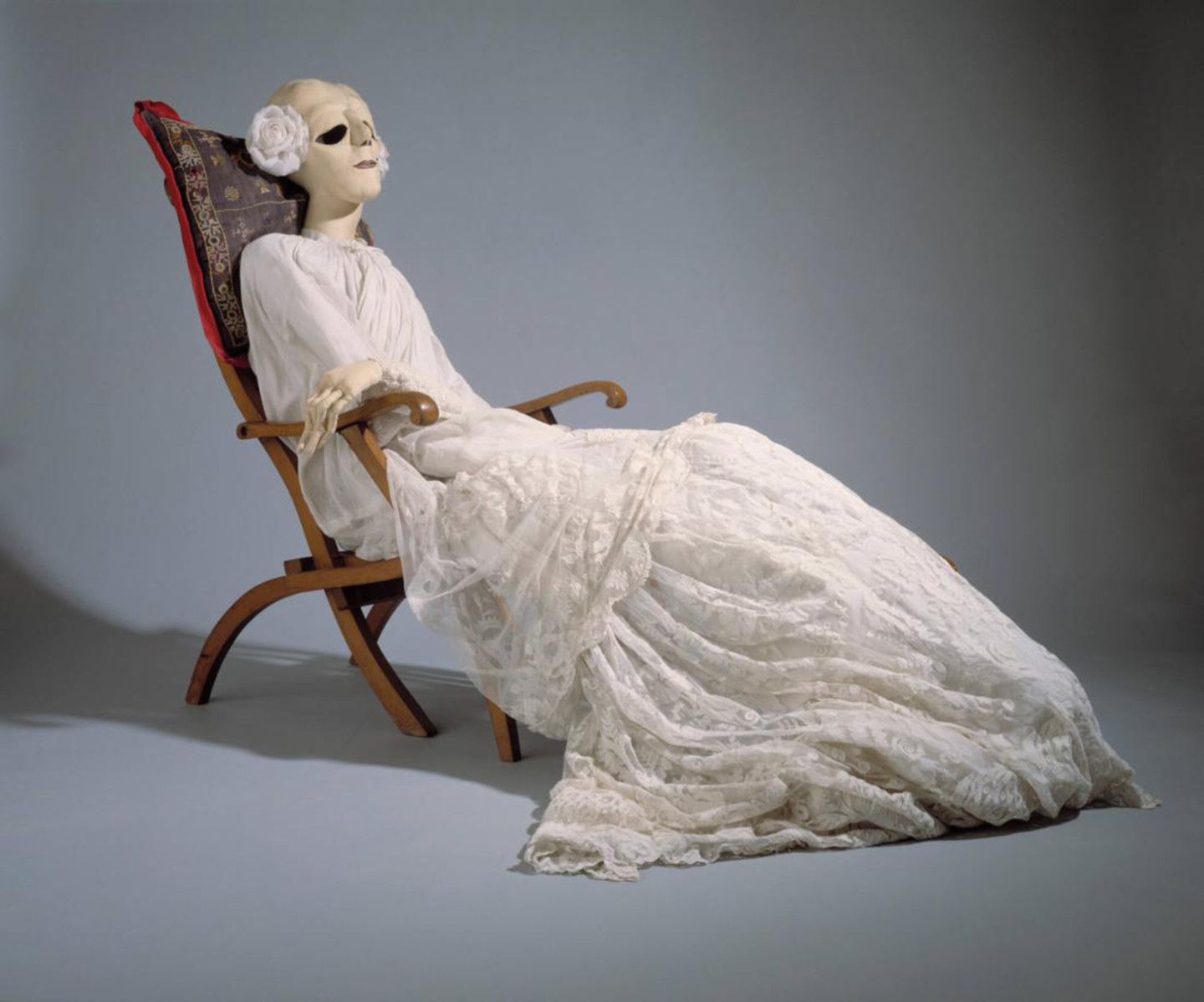
Hugo Ball
1886 – 1927
Germany
Hugo Ball at Cabaret Voltaire, Zürich, 1916
In February 1916, Dadaism was founded in Zurich when a group of artists, writers, and musicians gathered in a form of exile and protest movement at Cabaret Voltaire. Dadaism arose out of a time severely marked by the First World War and, one could almost say that its supporters were against most things – the bourgeoisie, commercialism, the war, nationalism, and a cultural climate that, according to them, was increasingly regulated. Their form of expression appeared irrational, cynical, anarchic, nonsensical, tragicomic. In Dadaism’s protest, the objectively political met the escapist, the concrete and the abstract. And frequently the Dadaist form of expression has been associated with the absurd.
In the summer of 1916, Hugo Ball is carried up onto the stage at Cabaret Voltaire in Zurich. Ball is wearing a costume that restricts his movements when he performs one of his nonsense texts that starts with:
gadji beri bimba glandridi lauli lonni cadori
gadjama gramma berida bimbala glandri galassassa laulitalomini
gadji beri bin blassa glassala laula lonni cadorsu sassala bim
Gadjama tuffm i zimzalla binban gligia wowolimai bin beri ban
o katalominal rhinocerossola hopsamen laulitalomini hoooo gadjama
rhinocerossola hopsamen
bluku terullala blaulala looooo …
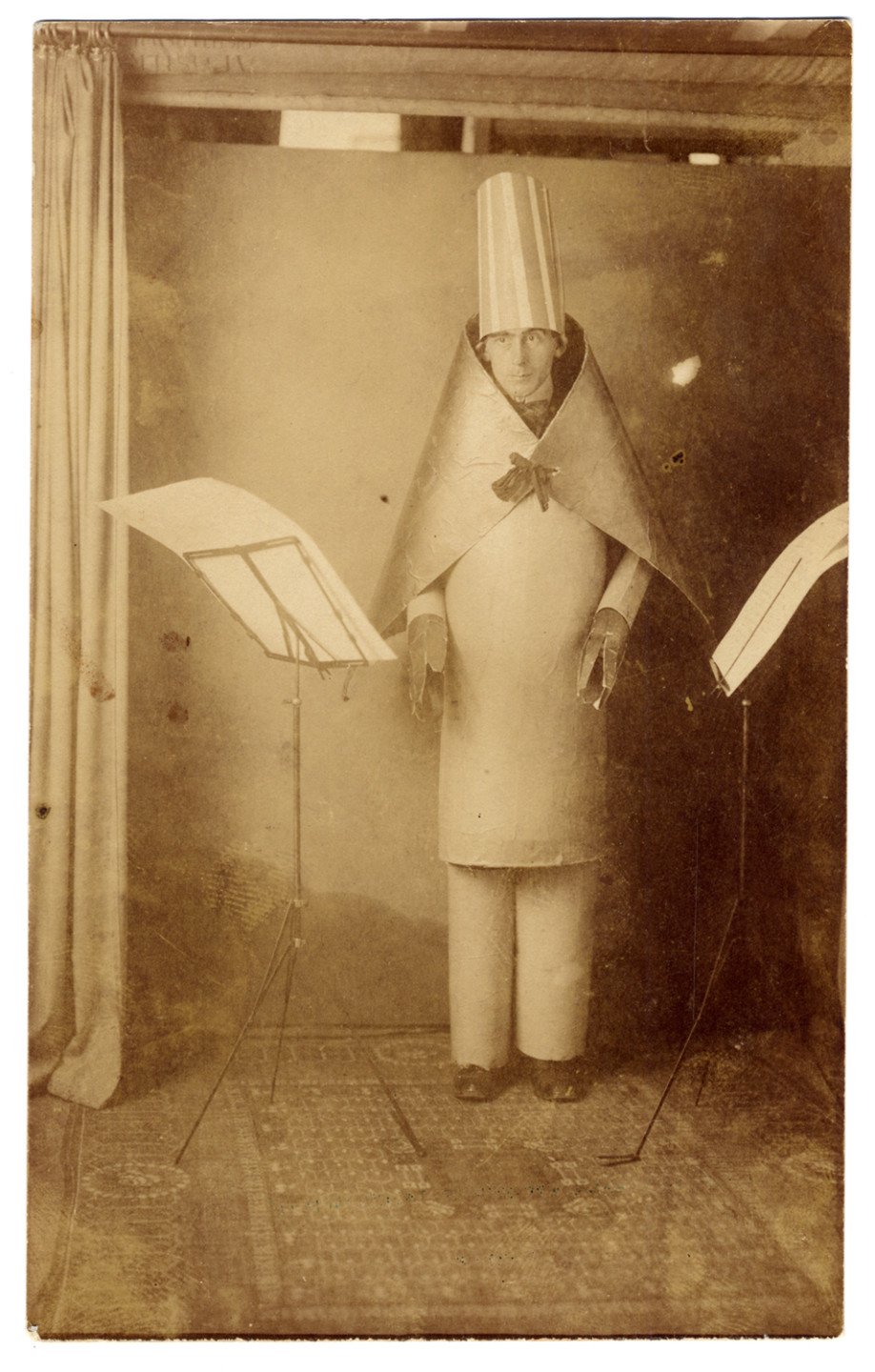
Enrico Baj
1924 – 2003
Italy
Punching General, 1969
Enrico Baj was inspired by Dada and Surrealism. He combined playfulness with a derisive and openly political position. His commentary on power is evident in the large-scale sculpture Punching General, where a stylised doll decorated with a bunch of medals could be used as a punching bag to vent our frustrations. The raised placement is ambiguous. On one hand, it can be seen as a display of mockery of power for public viewing. Another reading brings to mind the unattainable power.
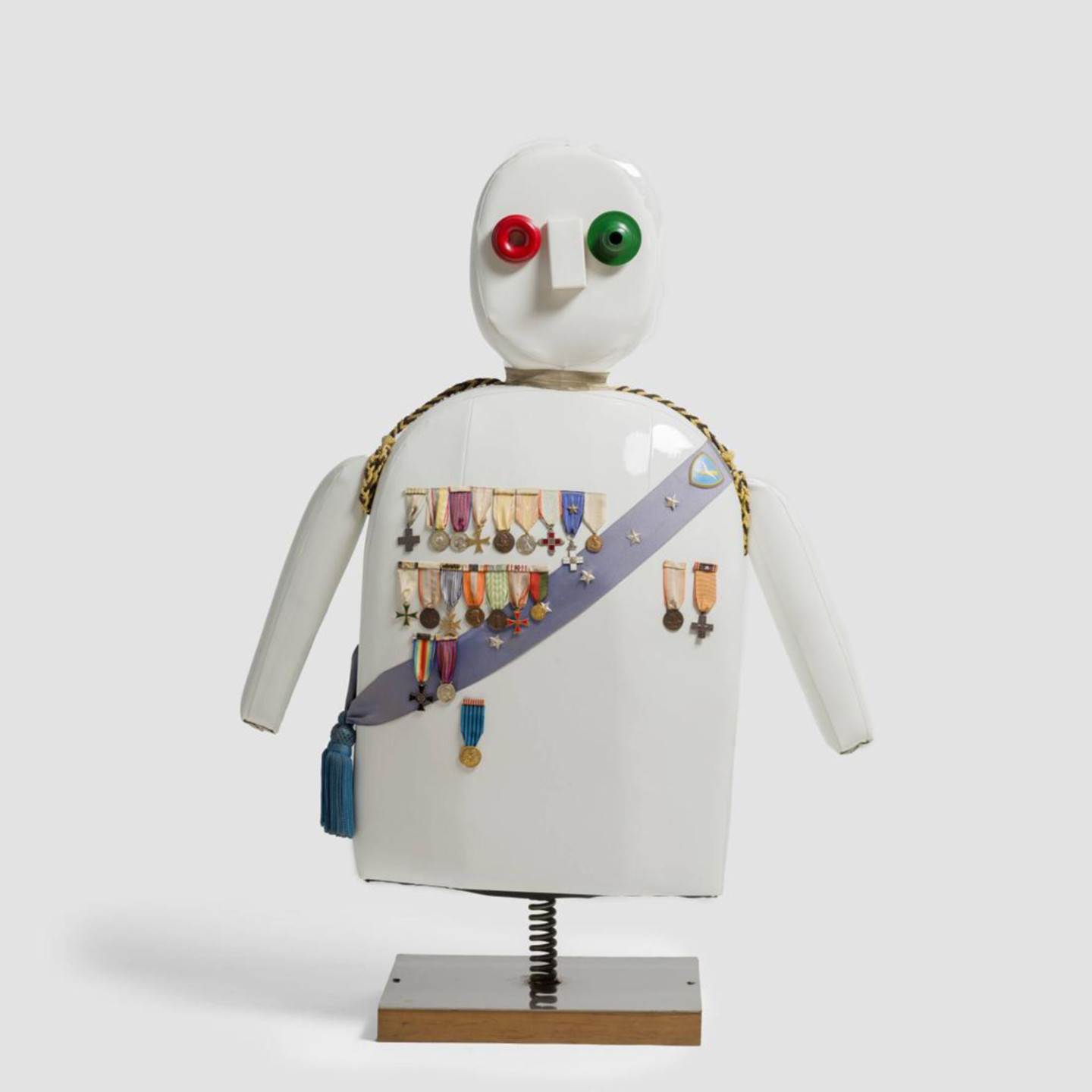
Marcel Broodthaers
1924 – 1976
Belgium
Société, 1969 – 1972
Dada’s interest in poetry and the questioning of art is also seen in the work of Marcel Broodthaers. Here we encounter institutional criticism and the exploration of the mechanisms of the art world, but also a discussion about power relations between the individual and society. In Society, he lets words and signs form the work in a way that seems to be as random as it is organised. Broodthaer’s interest in social structures as well as nature and art, emerges through the words that are linked in the work. Words are broken free from their established meaning in order to be reconstituted in a slightly absurd mélange of humour and gravity.
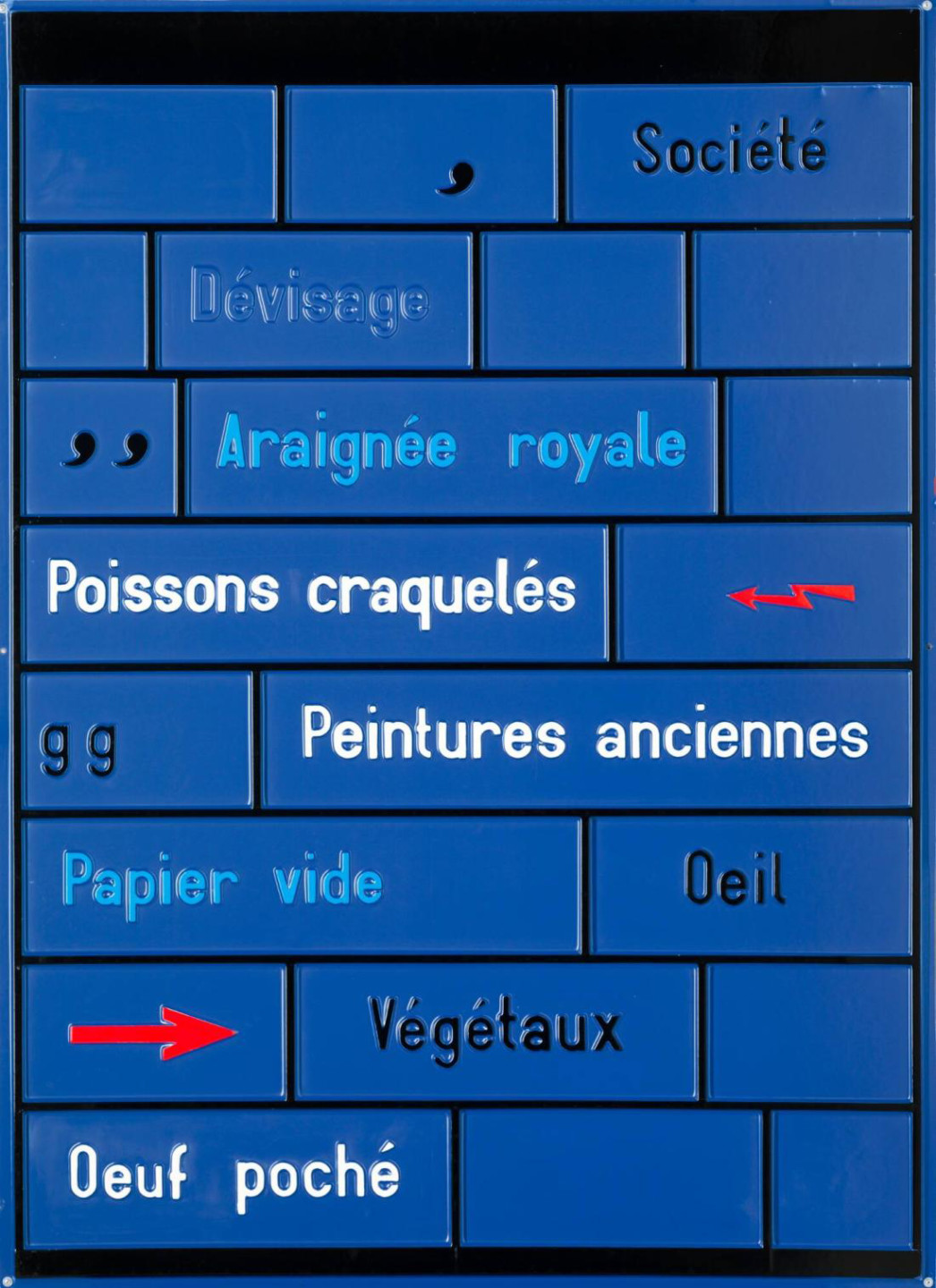
René Clair
1898 – 1981
France
Entr’acte, 1924
The film Entr’acte was produced by Rolf de Maré and first shown in Paris between acts of the Ballets Suédois’s performance of Relâche. The audience was encouraged to bring sunglasses, whistles and something to plug their ears with. The film is a Dadaist collaboration that incorporates many special effects and the tempo goes from slow motion to a fast ride on a roller coaster, and in between we follow a funeral procession. The film music was composed by Erik Satie, and in front of the camera we catch glimpses of artists such as Francis Picabia, Marcel Duchamp and Man Ray. In the end, all the actors are conjured away. When Relâche was first presented, it was a performance in which the dancers seamlessly mixed with the audience, but which also depicted and commented on the victims of the post-war era.
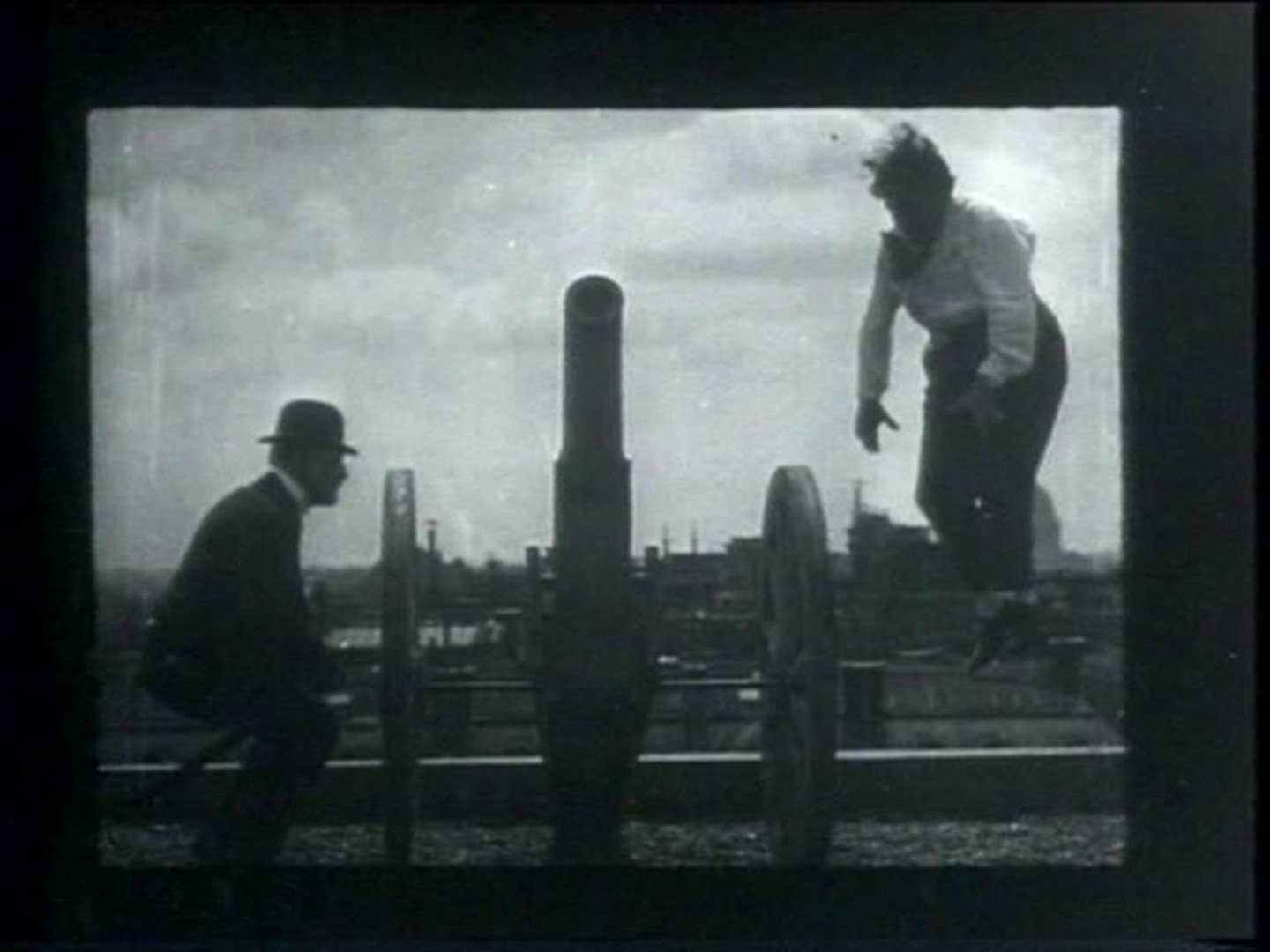
Karl Dunér in collaboration with Peder Freiij
b.1963 & b. 1954
Sweden
Company I, 1997
The series of works entitled Company, was created by Karl Dunér and Peder Freiij and a team of engineering students at the Royal Institute of Technology in Stockholm. In the sculpture’s open space, a kind of play unfolds in which a small figure slowly and seemingly randomly moves across the stage. The only limitation of the movement is, apart from the stage, that the figure can neither go backwards nor repeat an event. The work’s title is taken from a novella by Beckett, and at times pieces from the text are read by actor Sven Lindberg. At other times music and other sounds are heard. Company I conveys the low-key consideration of the conditions of existence, and the artists also renounce their power over the work and the event through the programmed chance. It is the repetitive paradoxical stage of the everyday in which everything and nothing happens, and everything and nothing is repeated.

Photo: Tobias Fischer/Moderna Museet
Bildupphovsrätt 2024
Robert Gober
b. 1954
USA
Cat Litter, 1989
Robert Gober’s realistic sculptures often refer to everyday objects, but also body parts. These meticulously crafted sculptures are loaded with ambiguous meaning where existential and psychological themes are given place. Casually placed on the floor, leaned against the wall, the attentive viewer will see a bag of cat litter, actually a sculpted plaster object. Originally, part of a larger installation, Robert Gober’s work Cat Litter (1989) is a comment on what we take on in an intimate relationship, taking care of each other under all circumstances.
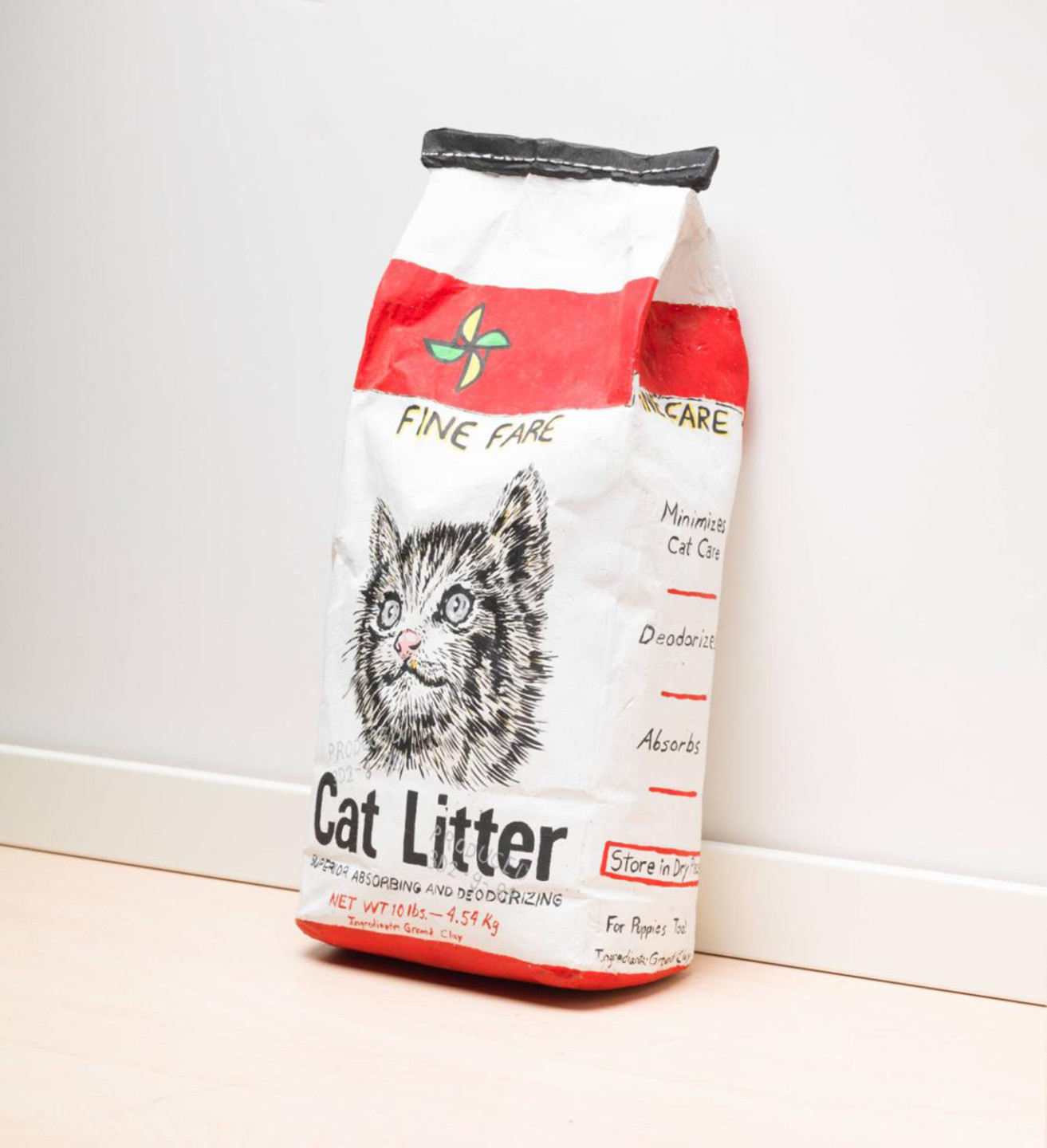
Sigurdur Gudmundsson
b. 1942
Iceland
rendez-vous, 1976
Sigurdur Gudmundsson’s work rendez-vous is part of his series Situations. It’s a group of photographs, or visual poems if you will, where the artist himself has often been placed in a funny situation, but which are always executed with palpable gravity. In the words of the artist himself, they express “very sharp articulated feelings”. It’s poetry of the everyday that often results in a zero-sum game, in which everything ends in the here and now.
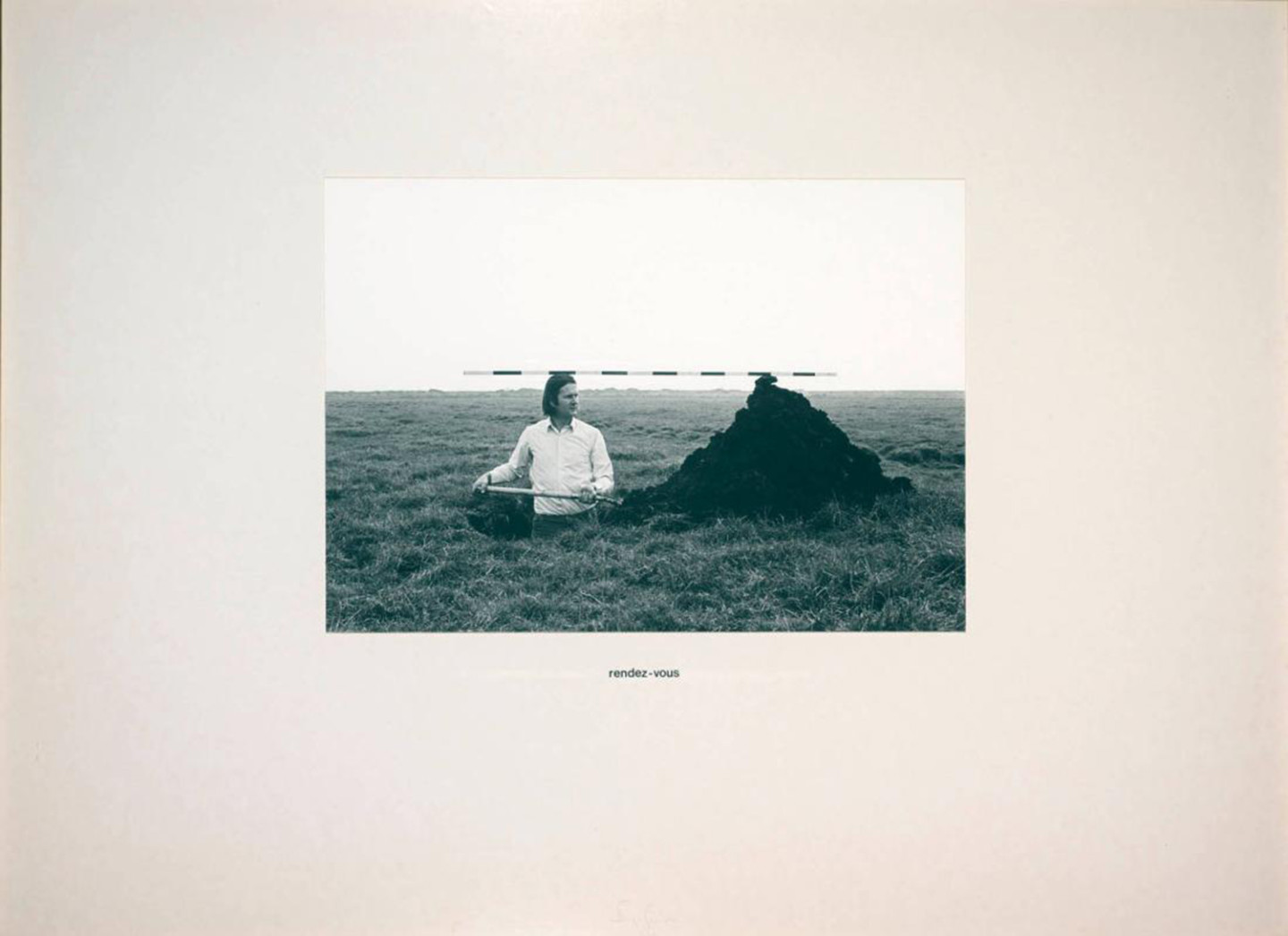
Joan Jonas
b.1936
USA
Waltz, 2003
In Joan Jonas’s short video Waltz a diffuse relationship drama with nature as a backdrop seems to unfold. Some simple props, consisting of a table and a couple of chairs, create the space for an indeterminate drama, in which the characters, Jonas’s friends, and her dog, are seen moving around among the trees and on the beach. They interact with props such as a red flag, white paper, and a mirror. In connection with the video, Joan Jonas has herself referred to both amateur theater and French outdoor theater from the 18th century.
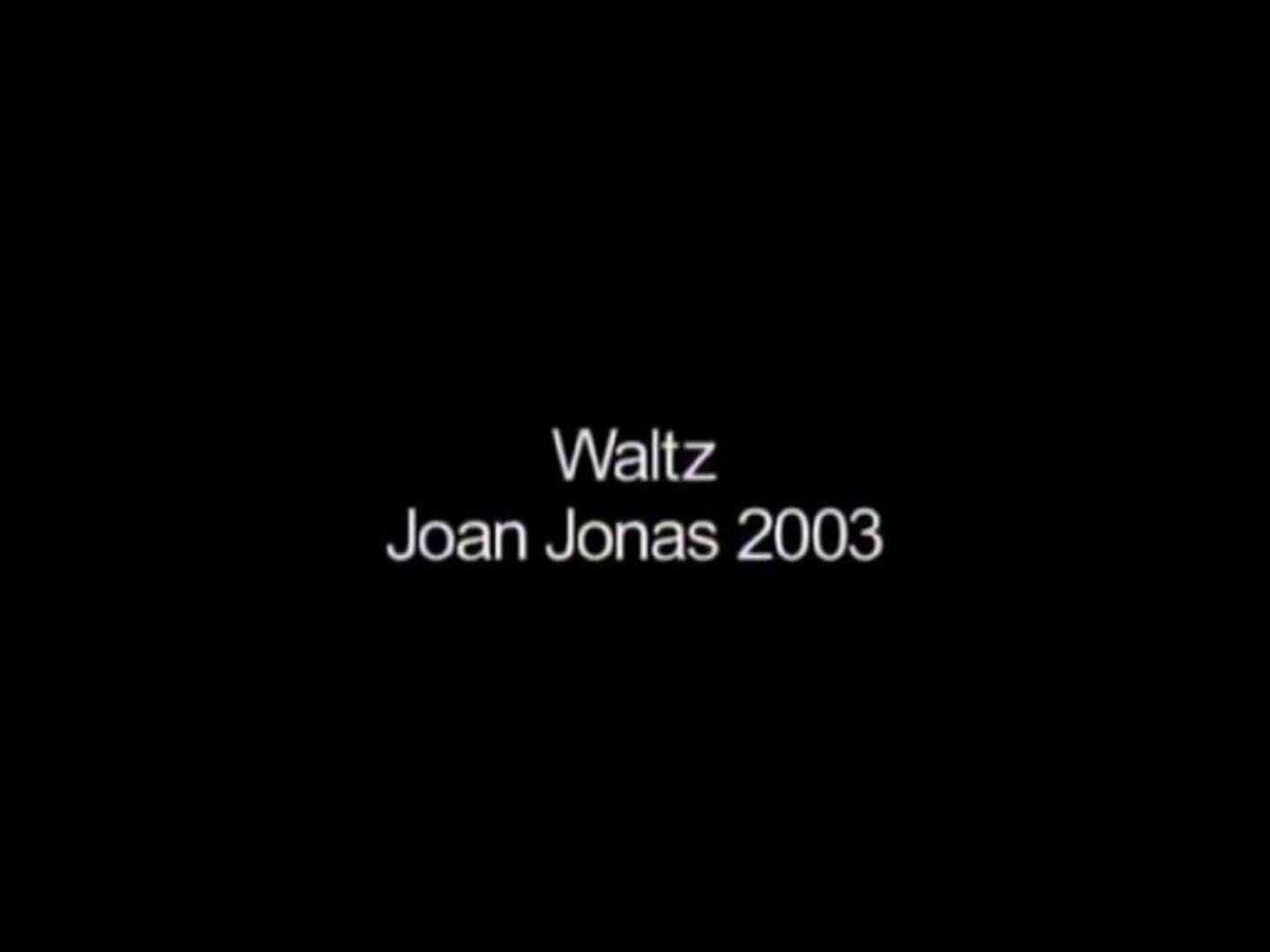
Greta Knutson-Tzara
1899 – 1983
Sweden
The Dadaist Group, around 1925
Greta Knutson-Tzara was a painter and writer. She moved to Paris already 1920.
Her paintings were characterized by a modernist style with classical themes such as portraits, interiors and still life. During the latter part of her life, her paintings became more surreal.
Her sketch-like drawing The Dadaist Group is dated ca. 1925. By that time, the already loosely connected group had dissolved and several of the members had moved on. In 1923, Knutson-Tzara’s husband, the co-founder of the Dada movement, Tristan Tzara, had organized a soirée in Paris. The programme included film, dance, theatre, and poetry readings by and including many of the artists who moved in the Dada circles. The evening came to an abrupt end when the stage was stormed by a group including the founder of Surrealism André Breton.
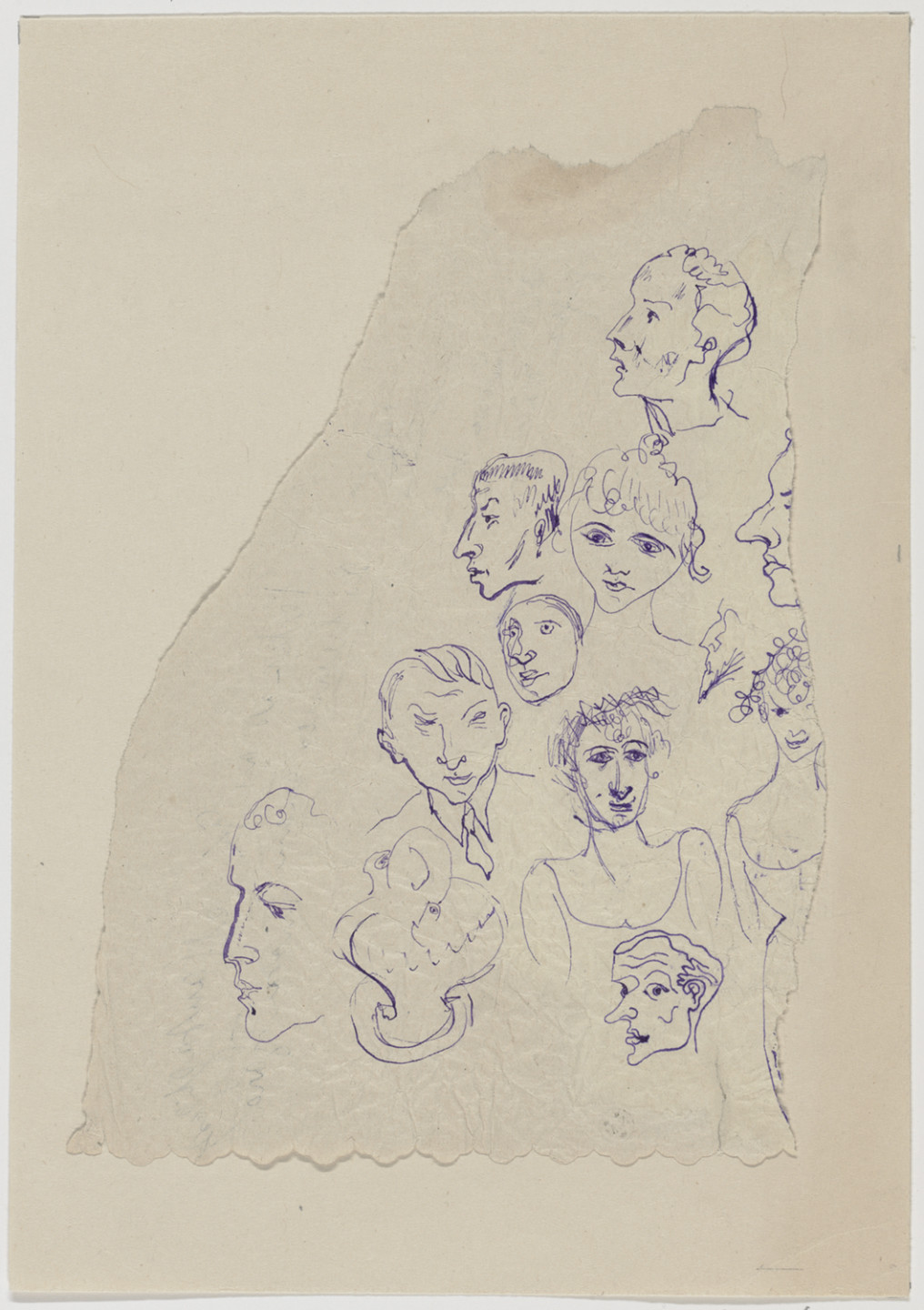
Tetsumi Kudo
1935 – 1990
Japan
No title, 1964
Tetsumi Kudo was part of the post-war avant-garde in Japan. In 1962 he moved to Paris and his art evolved from abstract painting towards objects and more theatrical performances. In his performance Philosophy of Impotence, Tetsumi Kudo demonstrated the ambivalences
and weaknesses of masculinity and society. Wrapped in cast phalluses, the artist can be seen falling helplessly and impotently from the stage. In his work, Kudo also criticized how ethical values have become more and more interchangeable, like commodities in a capitalist society.
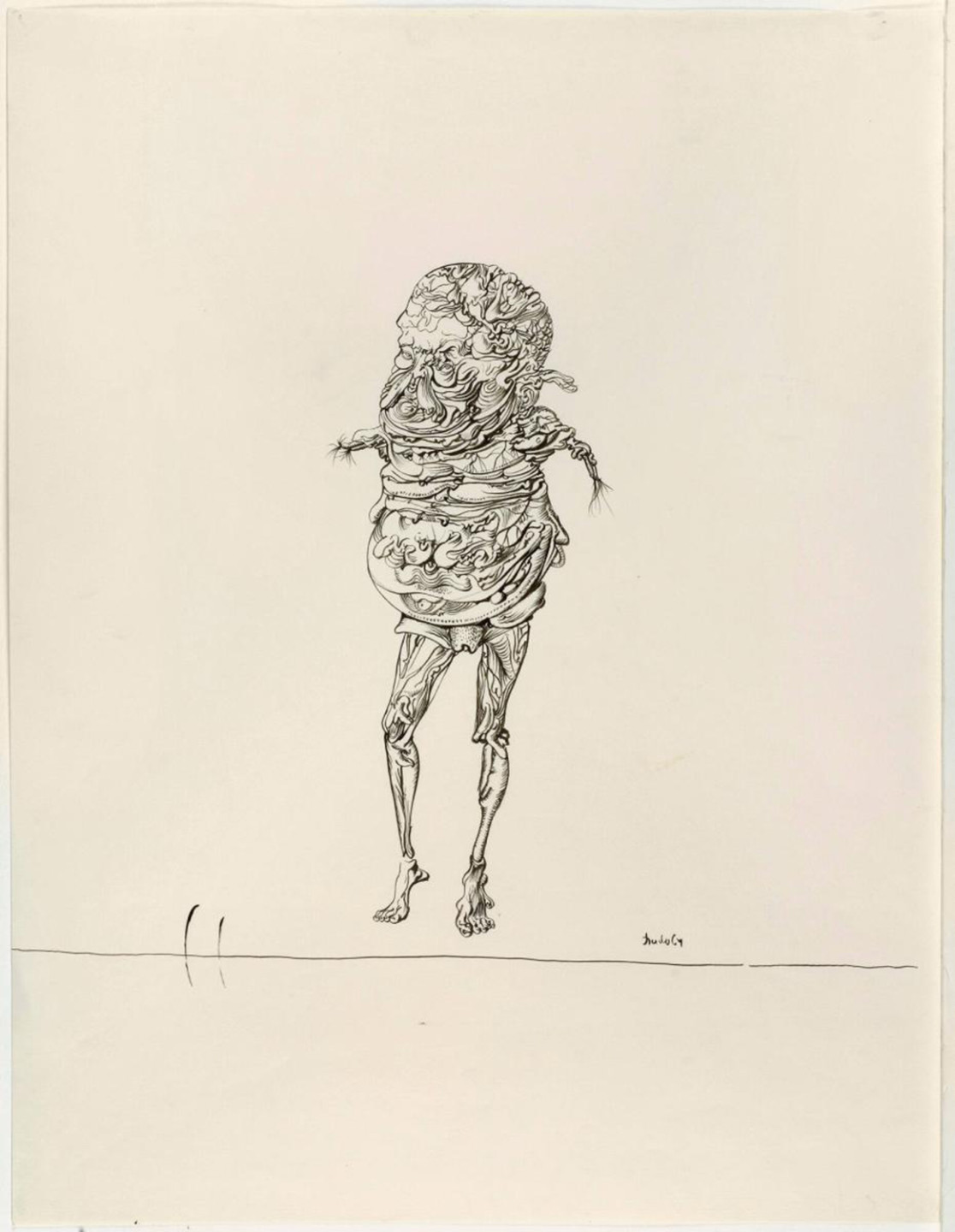
Ralph Eugene Meatyard
1925 – 1972
USA
Romance (N.) from Ambrose Bierce #3, 1962/around 1975
In the USA in the late 1950s, the optician and (self-proclaimed) amateur photographer Ralph Eugene Meatyard found a collection of masks at the department store Woolworths. He bought an assortment of them, and over the next thirteen years he persuaded friends and family members to wear the masks and pose for the clearly staged and directed images. With the help of the masks, the individuals are transformed into more enigmatic human beings, embodying the grotesque, comical and mystical. They could be anybody. Through his photographs Meatyard sought to expose inner feelings, inspired by literature, poetry, music and Zen Buddhism.
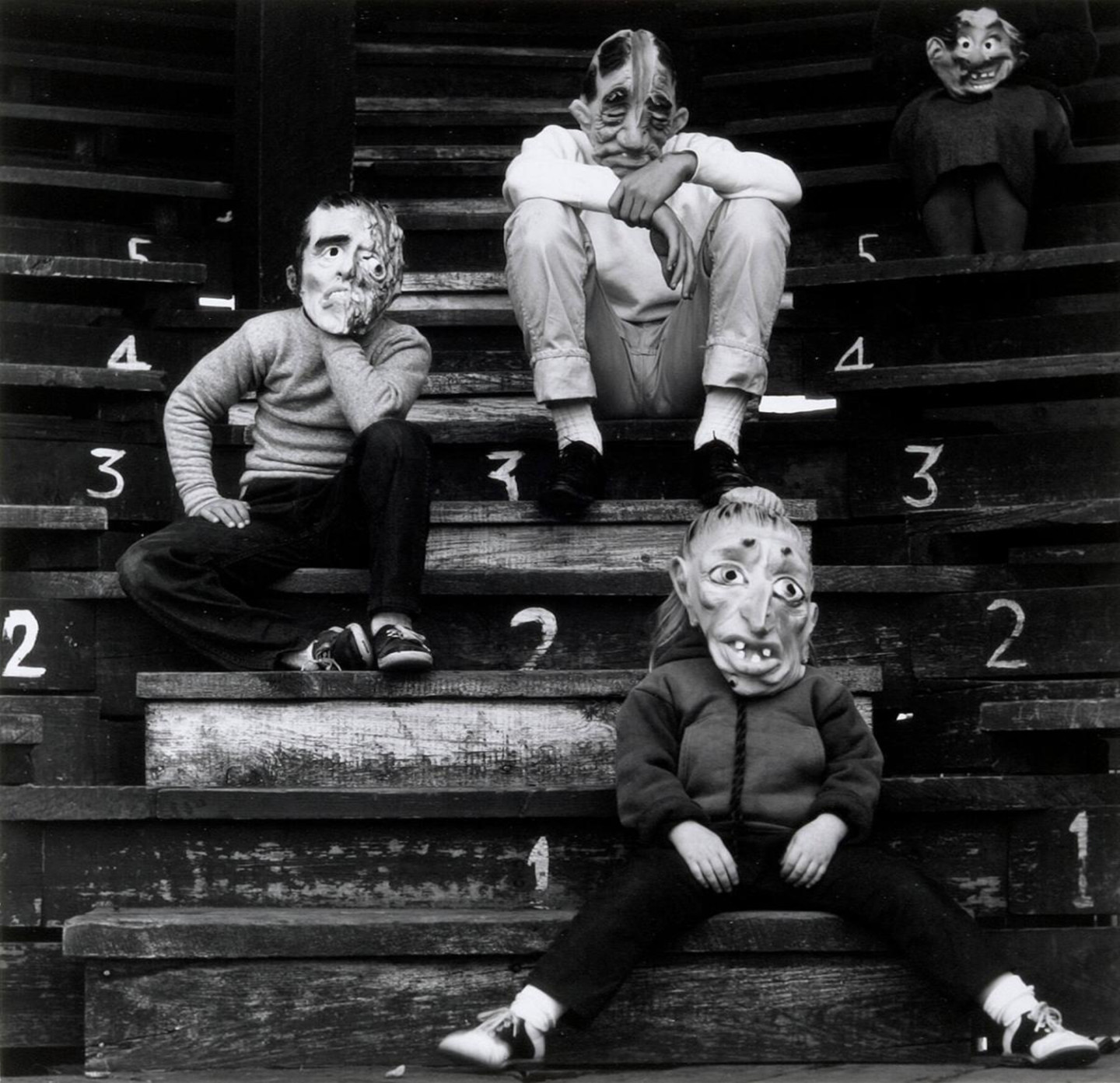
Francis Picabia
1879 – 1953
France
Première rencontre, 1925
Masks and costumes as recurring instruments in the exhibition represent something greater, not to be confused with concealment. They function as staging and amplifying attributes. In Francis Picabia’s painting Première rencontre (First Encounter), a man and a woman are portrayed wearing theatre masks with marked eyes and mouths reminiscent of naïve art. The painting communicates highly contradictory feelings in the form of both desire and repulsion.
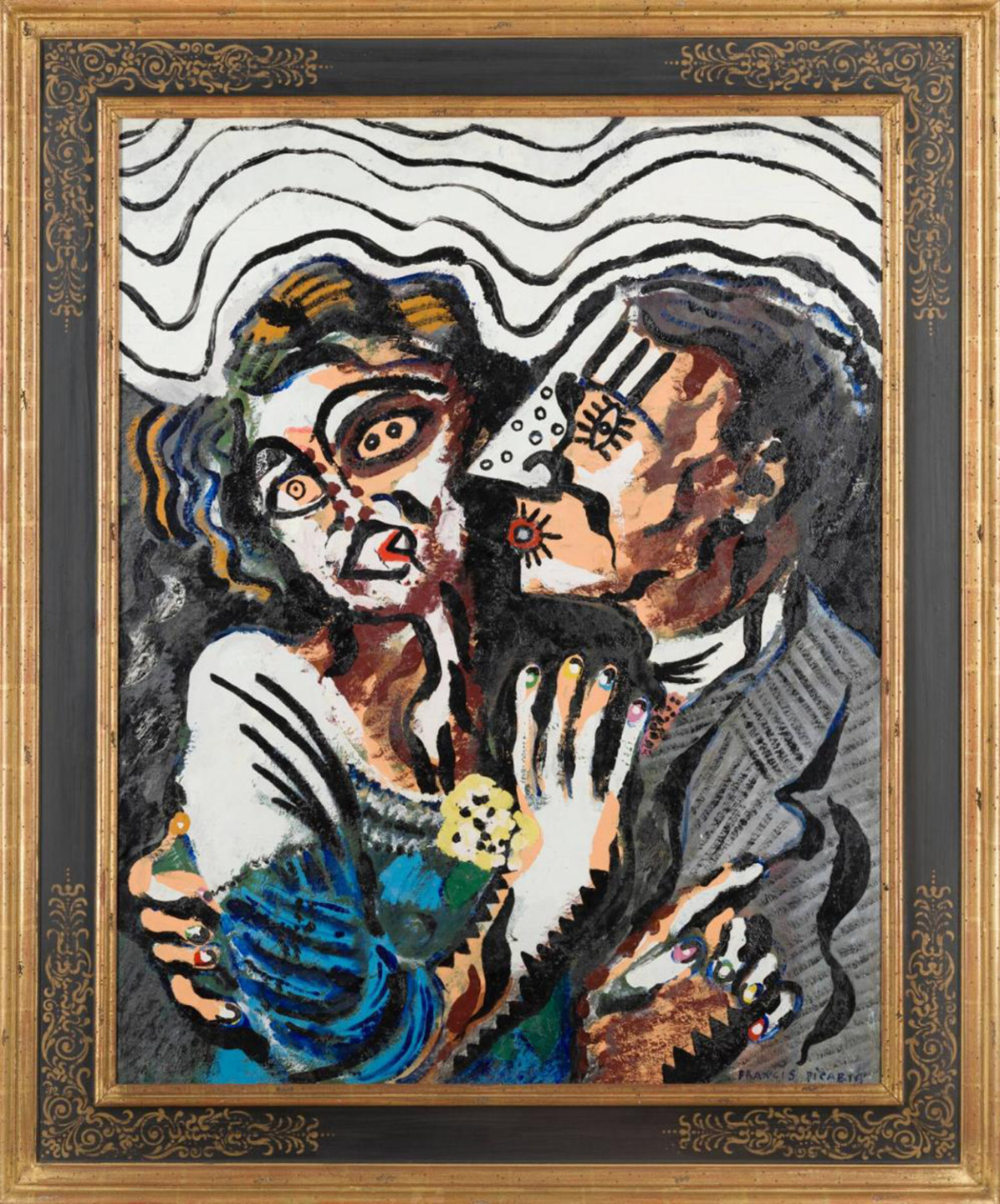
Man Ray
1890 – 1976
USA
Transmutation (Theatr), 1916
The collage technique and the experimental typography whichcame to be characteristic of Dadaism is prominent in Man Ray’s collage Transmutation (Theatr). Man Ray, just like some of his fellow artists at the time, expressed himself in a variety of techniques. In Transmutation (Theatr) he uses a horizontal spread from the daily newspaper The Sun. A number of words, letters, numbers and shapes are placed over the page. The background is given the function of a stage in which letters and shapes are allowed to dance. At the same time Ray has consciously covered the eyes of the people that feature in the images. The collage could perhaps be read as a commentary on live theatre’s relationship with the more modern cinema.
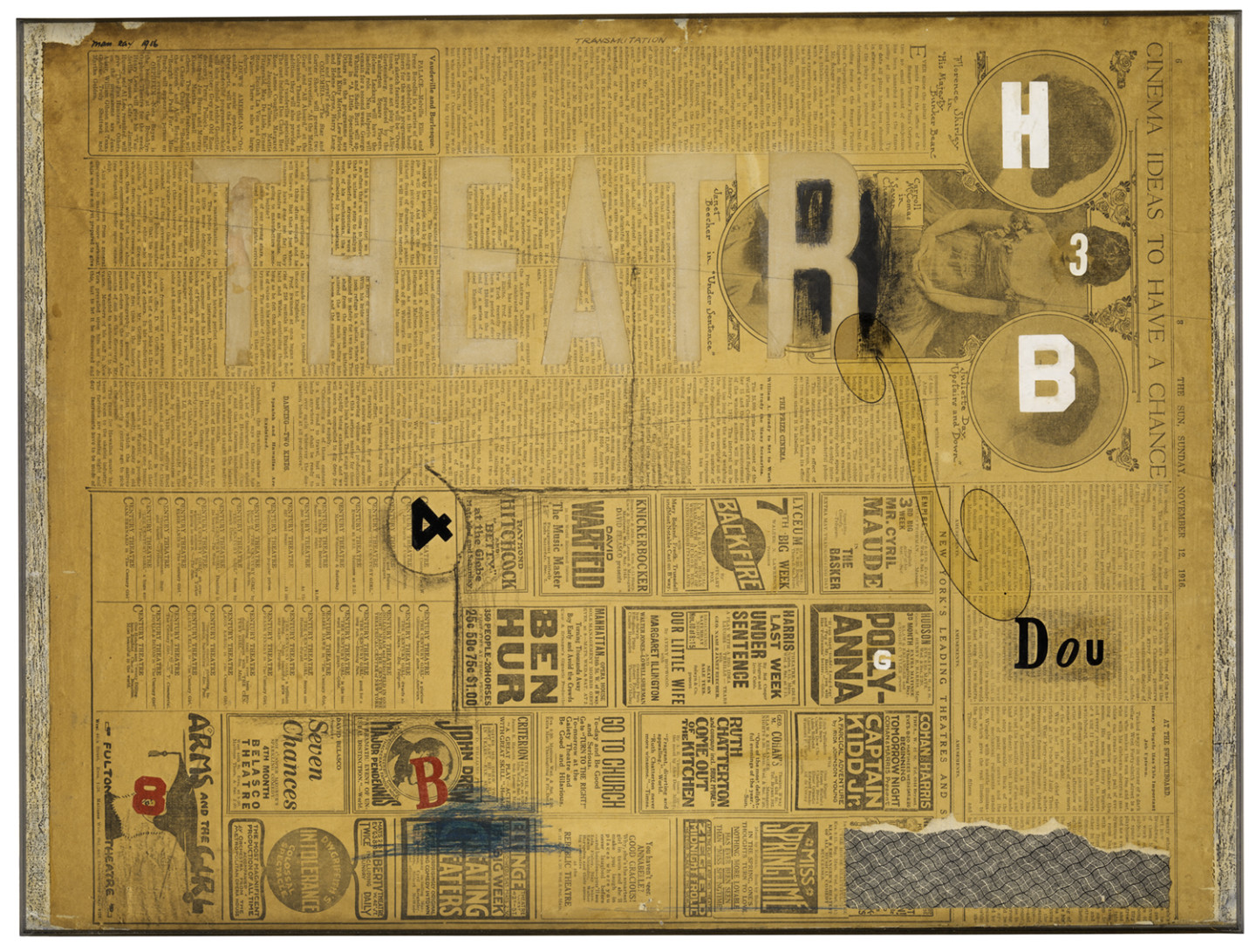
Marion Scemama
b. 1950
France
Silence=Death, 1989 2019
Marion Scemama’s photograph Silence=Death portraits her close friend and fellow artist David Wojnarowicz. On the right-hand side of the photograph, we can see a hand sewing up Wojnarowicz’s mouth with a red thread to protest and comment on the silence of the time surrounding AIDS and HIV. Wojnarowicz died of AIDS-related complications in 1992, only thirty-seven years old. As a viewer we are reminded of the fragility of life, as well as a society that was so late in taking responsibility when it came to research, information, and empathy.
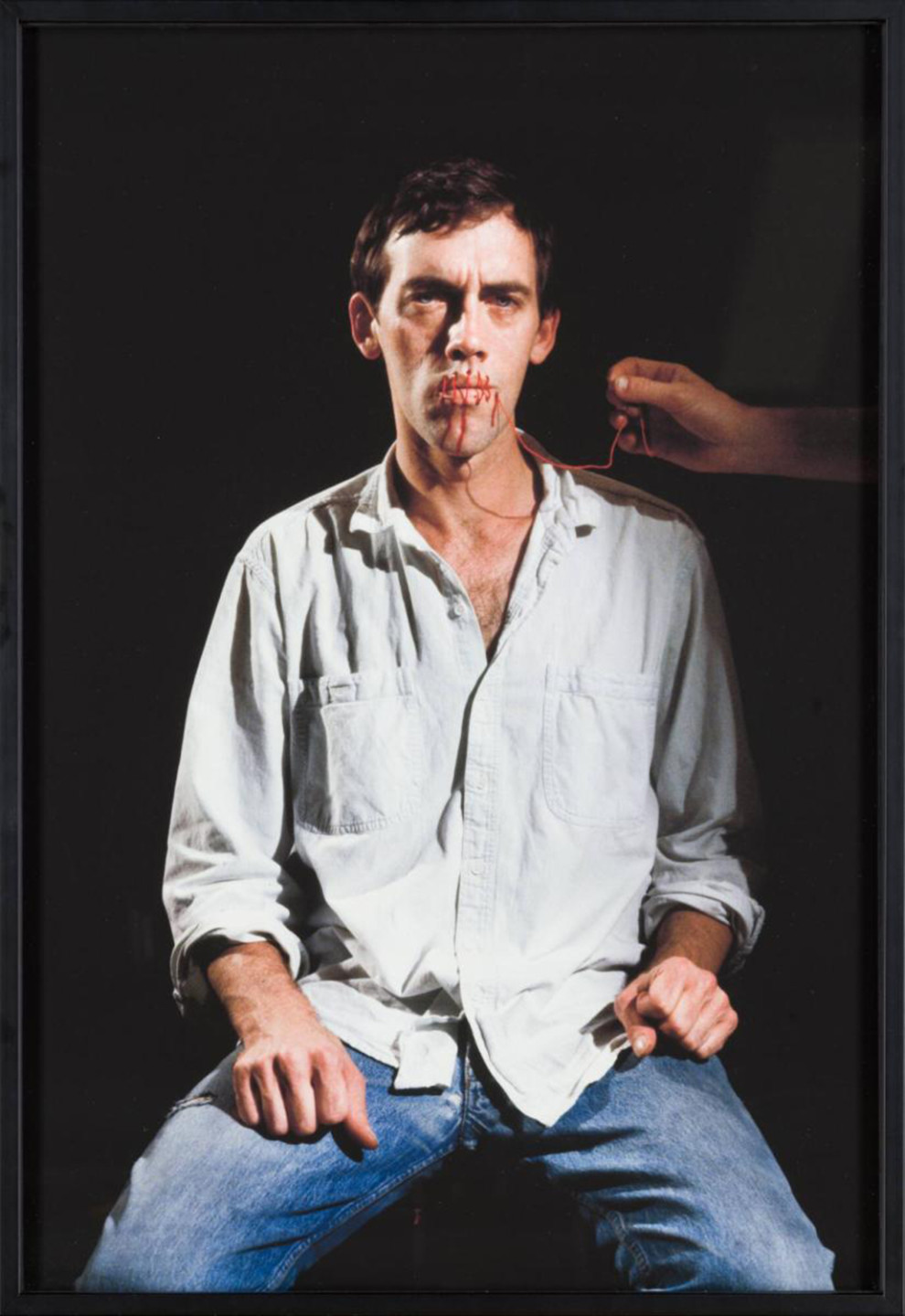
Dorothéa Tanning
1910 – 2012
USA
La Grotte, n.d.
Dorothéa Tanning’s images take us to a dream-like, supernatural place with murky, eerie undercurrents. From an early age, she found inspiration in gothic and romantic literature. These wild stories influenced her artistic style and themes. Tanning created both paintings, drawings and prints, and also made textile sculptures later on in life. Her recurring motifs include half-open doorways, large sunflowers and young girls, often in the form of erotically-tinged portraits. Tanning’s art deals with universal human feelings and experiences of ecstasy, elation, anxiety and obsession. Dorothéa
Tanning’s etching La Grotte is a work that evokes the feeling of looking through a crack in a door onto something unknown. With its surreal aesthetic it opens up to winding thoughts leading down into infinity.

Sophie Taeuber-Arp
1889 – 1943
Switzerland
Sophie Taeuber dancing, Zürich, 1917
The photograph depicts the artist dancing, dressed in a collageinspired costume and headgear. Purely visually, a link to her marionettes with which she was to start working a little later on, is not far off. Through Dadaist acts of resistance, the artists called into question the First World War, national borders, linguistic barriers – as well as the prevailing artistic expression. Against the background of this, the neutrally covered female body in the photograph of Sophie Taeuber has been described as a form of resistance that “embodies the absurd”. Just like the Dadaist poets worked with language in dissolution, Taeuber’s anonymous body and abstract movements could be understood as a universal, boundless language. Taeuber challenged predetermined roles and explored the human body in relation to a society in rapid change – based on social, political and cultural factors.
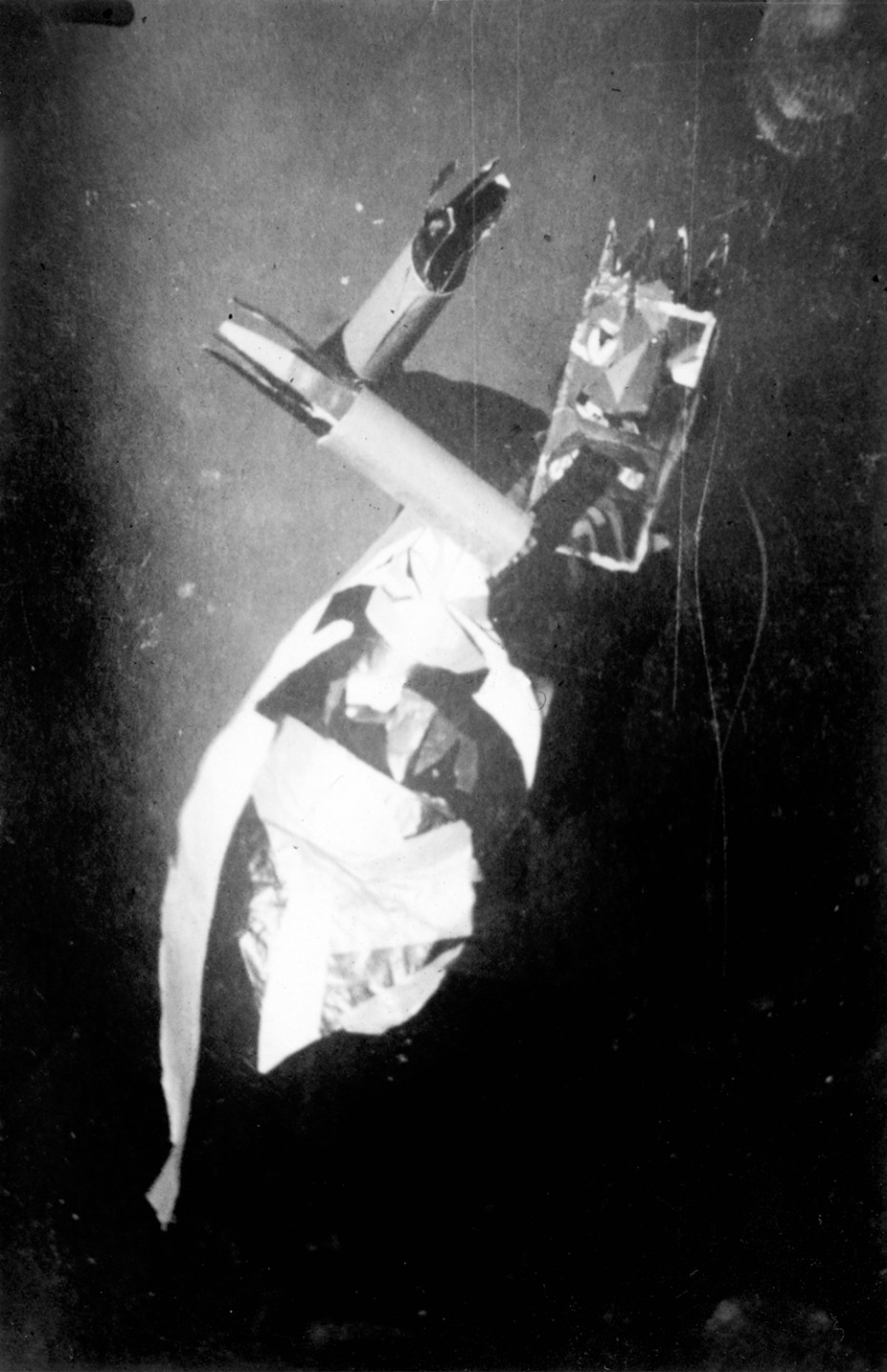
On the Absurd Drama That Is Also Life
“On the Absurd Drama That Is Also Life” is a group exhibition that invites the viewer to approach the absurd, farcical and theatrical with …
On the Absurd Drama That Is Also Life
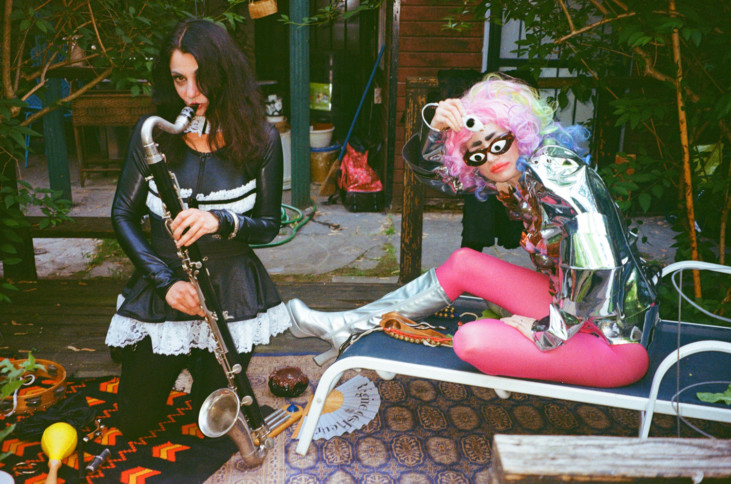
PING and SKULLS
As part of the extensive program in connection with the exhibition “On the Absurd Drama That Is Also Life”, Karl Dunér’s play PING …
Crossborder Artwork
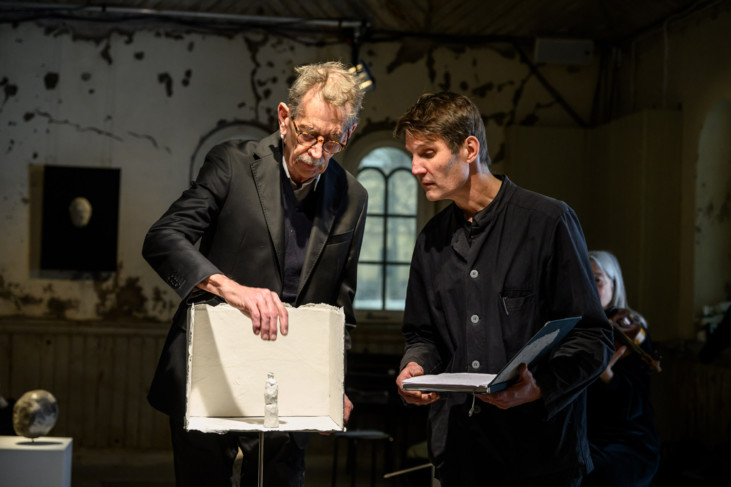
Kafé Sisko
To have a snack and eat and drink something delicious in connection with the museum visit is unbeatable! Sit down in our café, Kafé Sisko, to …
Kafé Sisko
